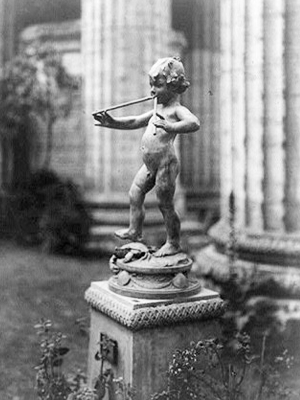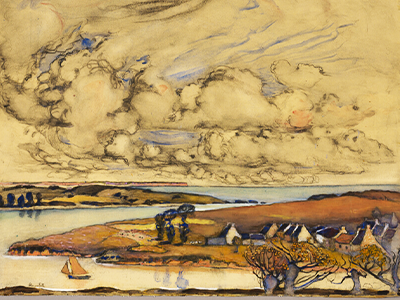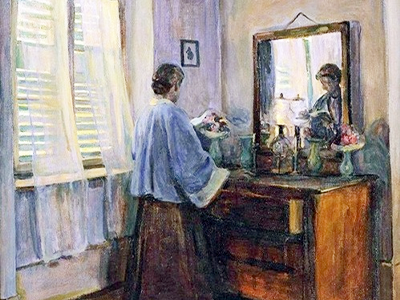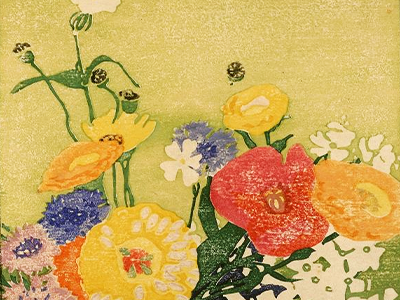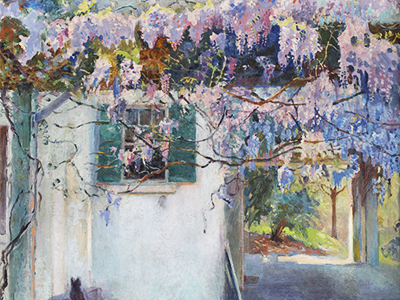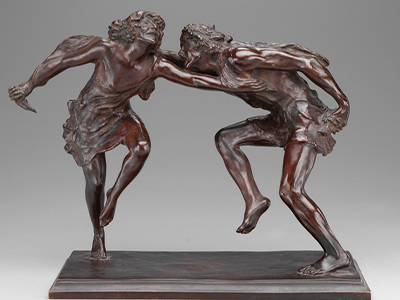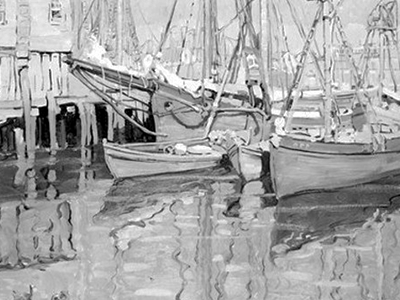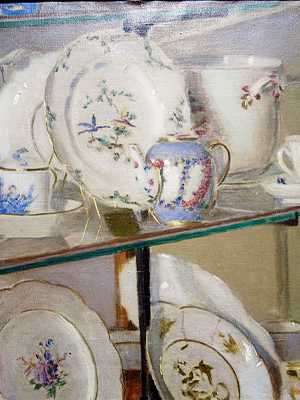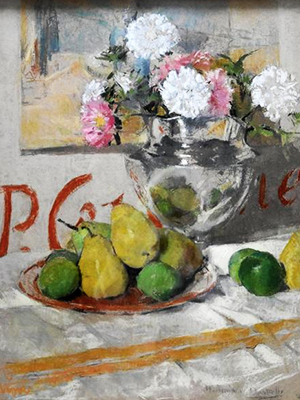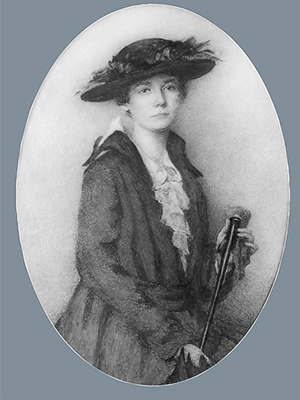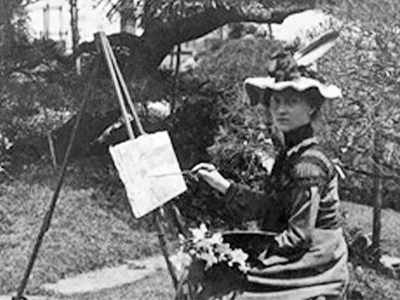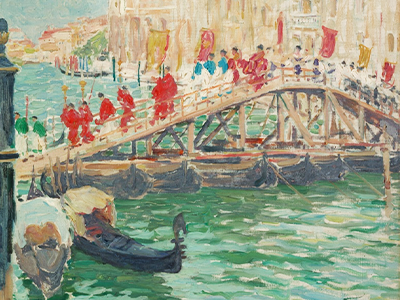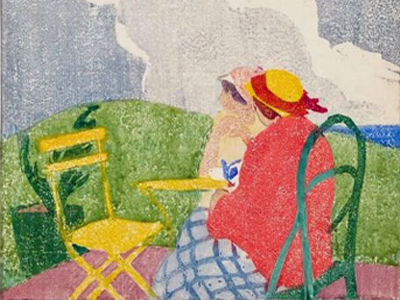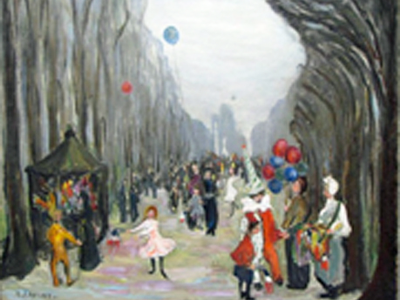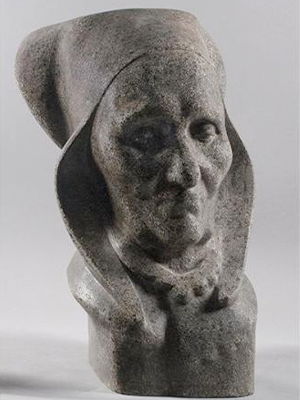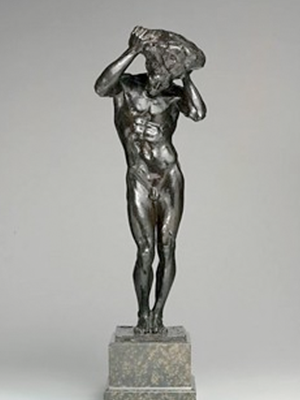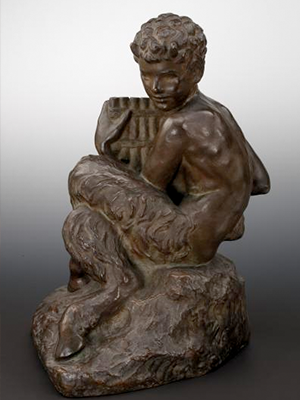AWAA Twentieth-Century Exhibitions
1900
At the dawn of the new century, the AWAA did not mount its annual exhibit.
And in lieu of the regularly-scheduled Salon de la Société nationale des beaux-arts, the Exposition Universelle dazzled hundreds of thousands of visitors at the Grand Palais that year. The rival Salon de la Société des artistes francais still took place in 1900, featuring a number of Club residents and/or AWAA exhibitors.
At the Exposition Universelle, or World’s Fair, the United States was among the foreign nations given its own pavilion. Many native sons and daughters were invited to represent their country, a great honor for any American artist, including those exhibitors who were either associated with the AWAA or the Girls' Art Club (or both). Biographical information about all the artists and a complete overview of the United States pavilion can be found in the Official Illustrated Catalogue.
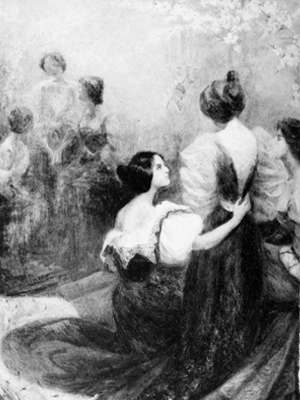
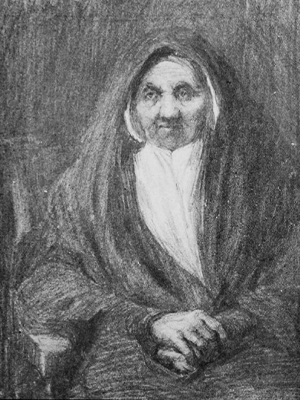
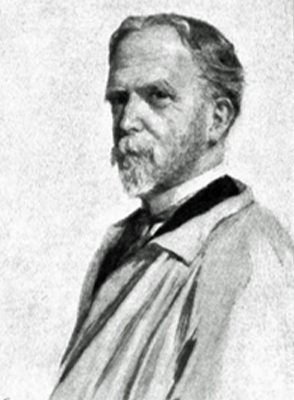
In alphabetical order, the women artists associated with 4 rue de Chevreuse were:
- Katherine Gilbert Abbott (painting, "Anxiety")
- Martha S. Baker (2 miniatures, "Miss Ethel Coe" and "Ideal Head")
- Martha Wheeler Baxter (a miniature, "Portrait of Miss T.")
- Marie Champney (miniature, "Portrait of Mrs. H. as Geisha Girl")
- Emma Lampert Cooper (painting, “The Bread Winners”)
- M.E. Dickson (painting, "Fancy Head")
- Lydia Field Emmet (painting, "Garden Days")
- Mabel Conyers Herring (unclear what she exhibited)
- Caroline A. Houston (2 miniatures, "Portrait of Miss C." and "Portrait of M.J.C.)
- Mary Fairchild MacMonnies (painting, "Lilies and Roses")
- Willie Betty Newman (painting, "Reverie")
- Elizabeth Nourse (painting, "In the Church at Volendam, Holland")
- Virginia Richmond Reynolds (3 miniatures, each entitled "Portrait")
- Janet Scudder (sculpture, "Decorative Panel for Music Room")
- Rosina Emmet Sherwood (painting, “Portrait Study” and portraits of children in drawings section)
- Margaret Spicer Simson (2 miniatures, “Portrait of Miss Money Coutts” and “Portrait of Miss Agnes Money”)
- Harriette R. Strafer (miniature, "Portrait of Mrs. S")
- Enid Yandell (sculpture, "Mermaid and Fisher Boy" pewter tankard)
1901
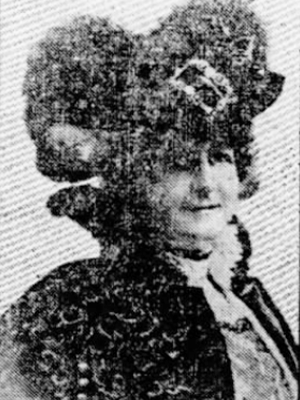
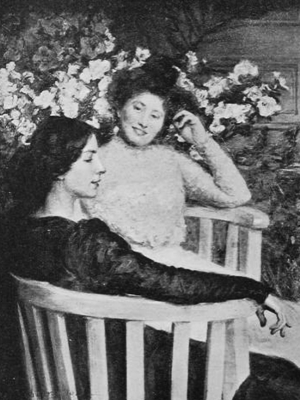
The annual AWAA exhibition was held at 4 rue de Chevreuse from March 2 to March 9, 1901. The association president for the year was Mary Fairchild MacMonnies, the vice president was Elisabeth Kruseman Van Elten, and the secretary was Charlotte Van Buskirk.
In January 1901, the AWAA hosted a competition open to all American women in Paris. California artist Marion Holden designed the winning "Die" (logo) for the Association.
The Buffalo Evening News reported on March 20, 1901 that the show’s judges were artists Walter Shirlaw, Walter McEwen, and Will H. Low. It highlighted Della Garretson who exhibited two paintings, including one called “Spring” with a blossoming thorn-apple tree (3).
A much longer overview of the show at the Girls’ Art Club appeared in The Brooklyn Daily Eagle on March 31, 1901. Though it praised the overall quality and commended more-established women artists for exhibiting their work alongside that of less-experienced students, the review was not without criticism.
- A watercolor by Elizabeth Nourse, “Sleeping Baby,” was deemed “hardly worthy of the painter’s reputation” (23).
- Mary Shepard Greene, a well-regarded painter from Brooklyn, showed “two pictures which are not specimens of her best work.”
- Elisabeth Kruseman Van Elten exhibited a self-portrait that was “ambitious in size” but the reviewer concluded that all art students err this way and did not fault the painting further.
Other artists received only praise.
- The famed Anna Klumpke showed a watercolor, “Ellen Font Dodo,” which was a “pretty bit of color, well managed.”
- Elizabeth Strong’s portrait of a dog “immediately attracts attention.”
- The portrait of Miss Murphy by Lucy Lee-Robbins was popular at the exhibit.
- Charlotte Van Buskirk’s small painting of La Conciergerie and the Pont au Change “shows that she has a correct idea of just values.” The reviewer felt she should be encouraged to continue producing these kinds of landscapes since “there are no women of whom I have any knowledge who make that class of paintings a specialty.”
- Alice B. Muzzey (sometimes misspelled as Mussey), exhibited a study of the Luxembourg gardens that supposedly caught the eye of Mary Fairchild MacMonnies (Buffalo Morning Express, November 13, 1902, p. 9).
- The last artist mentioned was Indiana native and sculptor Janet Scudder, who exhibited a bas-relief portrait of Mrs. Van Beuren.
The critic for the American Register provides even more details on this exhibit, which he claims demonstrates that the AWAA, “may be congratulated on a most interesting demonstration of their talent and industry, which proves at least this, as compared with previous exhibitions of female art, how swiftly the weaker sex is attaining to executional levels of the stronger, especially among the Americans" (March 9, 1901, p. 3). He lists the following artists:
- Mathilda Lotz, “Le Repos du Chamelier”
- Mrs. E.C. Peixotto, three landscapes, “A Church, Nervi,” “The Harbor, Rapallo,”, “Fishing Boats, Rapallo”
- Paula Himmelsbach, “Spanish Woman”
- Eleanor Clarke plein air “Study” of a nude
- Marie Preble, Still Life
- Marie MacMonnies, « Galerie d’Apollon (Louvre) »
- Elisabeth Kruseman Van Elten, portrait of a woman mainly in black and a Dutch interior
- Charlotte van Buskirk, old country church and bridge at night
- Miss Dillaye [Blanche], sunset with a sea of purple mist, identified as a “chef-d’oeuvre;” etching, “Mist on a Cornish coast; and “The River.”
- Susie Hartrath, “Child with Doll;” a landscape; and “The Little Sister.”
- Mabel Reed Deming, “Mother and Child.”
- Susan Watkins, “I dressed myself in an old-world gown;” “In the Garden”
- Bertha M. Waters, portrait of Miss Alice Cooper
- Mary M. Wetmore, portrait of a mulatto woman, sketches “Le petit Hollandaise;” “La petite Marguerite;” “Portrait de vieille. »
- Elizabeth Strong, portrait of a dog “Puff.”
- Mary Van der Veer, two Dutch interiors
- Louise Wood, “Etude” of a boy and a girl sitting by the riverside; miniature of Mlle W.
- Josephine Sandford, “Study of a Head”
- Marie Lorraine Squire, “Haunted House;” “Ludlow Castle”
- Alice E. Rumph, “Dutch interior”
- B. McArthur, portrait of a girl in a blue bodice
- Eleanor Norcross
- Anna E. Klumpke, pastel sketch, “Elle font do-do"
- Rebecca Jones, “By the window;” “In the Garden;” “Hanging Lanterns”
- May Hart, “Study” of a girl dressing before a mirror
- Florence Esté, “Les Ajoncs” and “Les disparus »
- Miss Greatorex, "Washboat, Moret" and "Barge on the Loing"
- Sherman Clarke, still life
- Clara Walsh, “Petit Son”
1902
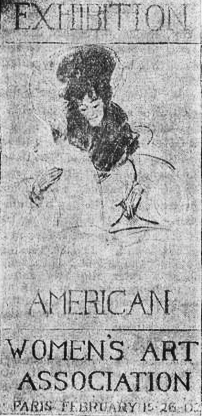
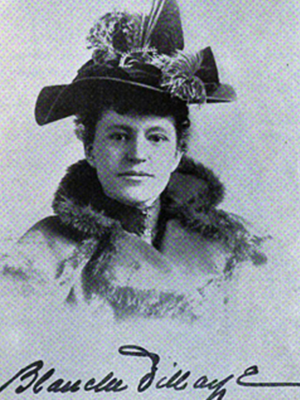

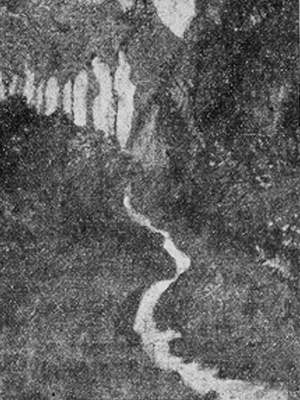
Mary Fairchild MacMonnies, painter and president of the AWAA, coordinated the annual two-week exhibition, which opened on February 13, 1902. Other board members included: E.F. Kruseman van Eltern, Vice President; C. Van Buskirk, Secretary and Treasurer. The judges were H.S. Bisbing (painter and engraver), S. Seymour Thomas (also a painter and engraver), and Henry Ossawa Tanner (renowned artist based in Paris). The hanging committe was composed of: Blanche Dillaye, Della Garretson, Alice H. Barri, and Mary C. Barringer. The show included 200 paintings, as well as pastels, drawings, watercolors, and miniatures, all by American women.
Among those who exhibited were:
- Inez Eleanor Bate, (3 works, one view of Venice and another of the front door of a fruit shop)
- Miss Churchill [Minnie L. Churchill]
- Blanche Dillaye (watercolor meadow at twilight)
- Meta Vaux Warrick Fuller (a "Rodinesque" sculpture)
- Della Garretson, "An October Afternoon," "The Village"
- Sisters Kathleen Greatorex (portrait of a young man and some landscapes) and Eleanor Greatorex (girl reclining in green cushions and snowy town of Moret)
- Eliza Voorhis Haigh
- Mrs. May G. Hart ("interesting" village scenes)
- Rebecca Jones
- Mary Fairchild MacMonnies (two paintings of a terraced garden with views of villas of Giverny)
- Miss McArthur [Betty McArthur]
- Elizabeth Nourse (peasant woman holding infant playing with gem)
- Mabel Packard
- Mary Smyth Perkins (3 studies of Luxembourg Gardens)
- May Audobon Post (little Dutch girls)
- Lena Qualley
- Alice Rumph (ballet girl tying a slipper)
- Lucy Lee-Robbins
- Ella Thomas
- Charlotte Van Buskirk, AWAA secretary and treasurer for 1902 (painting showing evening effect in a village)
- Elizabeth Kruseman Van Elten, AWAA vice president for 1902 (painting of a family of peasants)
- Bertha Mary Waters (petite blanchisseuse standing in front of flowing linen)
- Louise Wood
Exhibition details were published on February 16, 1902 in The Chicago Tribune (10). A lengthy review of the show by Blanche M. Russell also appeared in Brush and Pencil's March 1902 issue (350-351). Russell notes: "Landscapes and figures in the open air were in the ascendant. As a whole, the display was characterized by a judicious selection of subjects and by intelligent treatment" (351).
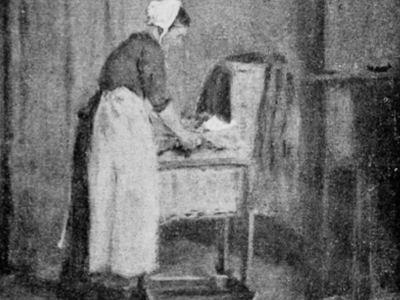
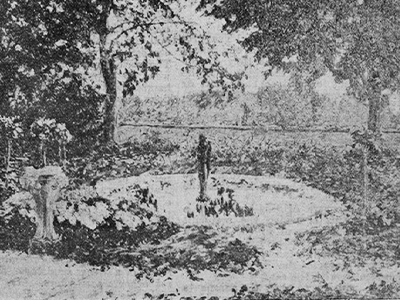
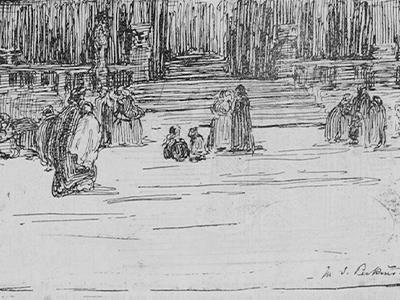
Another comprehensive review of the February 1902 show appeared in The New York Herald Paris edition on February 23 (Supplement 1). The review critiqued the Club’s exhibition space as small and lacking good light, perhaps to encourage American donors to establish a larger gallery in Paris for the many gifted young artists who relied on the AWAA to show their work. The art itself was considered good, including an “unusually strong showing by the younger artists,” prompting the exhibition to remain open an additional four days until February 30. As usual, a wide assortment of artists and works were praised, critiqued, and described.
- Rebecca L. Jones, a painter from Georgia who was studying in Paris with Garrido, exhibited three pictures, “each displaying a nice sense of composition and a love for color-harmony in a low key.” The most popular of the three works was a Breton cottage scene depicting an old woman and her middle-aged daughter. Another of the paintings by Jones, “The Morning Meal,” showed a pensive older peasant woman holding an empty bowl in her lap.
- Kathleen and Eleanor Greatorex, originally from New York, each showed several works. The finest watercolor in the show (according to this reviewer) was Eleanor’s “La [sic] Rêve,” showing a beautiful young woman asleep and holding a Japanese fan. Her painting of a snowy village served to “emphasize her versatility.” Kathleen’s submissions were “well-executed watercolors of flowers and still life.”
- Another New Yorker, Jeanie L. Boyd, was a former Club resident who worked in a studio on Boulevard Raspail and had recently returned from a trip to Japan. Two of her paintings featured Dutch subjects; “What the Stork Brought” showed a happy young mother leaning over her first born’s cradle.
- Elisabeth Kruseman Van Elten, believed to have inherited her famous father’s artistic talent, showed a painting called “At the Close of Day,” depicting American country life, complete with farmhouse, farmer, and a family returning from work in the fields. She also exhibited a portrait of Alice T. Searle, a Brooklyn miniaturist studying with Mme de Billemont-Chardon in Paris. Searle apparently showed several of her miniatures at this 1902 show.
- Animal painter Elizabeth Strong exhibited the “vivacious head of a Scotch collie.”
- New York artist Charlotte van Buskirk, a frequent AWAA officer about whom little else is known, exhibited two paintings, “The Pine Trees,” and “Il fait Nuit.” The latter painting was a twilight landscape thought to capture “the majesty and the mystery of early night.”
- Lucy Lee-Robbins, an associate of the Salon des Beaux-Arts and a pupil of Carolus-Duran, showed a nude woman reclining on a canopy-covered divan, as well as a portrait of a young woman in a pink dress with a black velvet bow. These works were "masterly pictures that fully sustain her well-established reputation.”
- Mary Fairchild MacMonnies exhibited two characteristic garden scenes, one of a bright summer day and another called “October,” featuring a large fountain in the center of the canvas.
- May Bell Koll of Ohio [real name Elizabeth May Bell Koll] was a pupil of Jeanie L. Boyd who exhibited a watercolor, “Les Étudiants,” featuring two Japanese dolls “reading” a leather-bound book.
- Betty McArthur from Arkansas exhibited three works, including a sketch of her larger painting, “The Bookbinder,” showing a woman at a desk completely absorbed by her work.
- Minnesota artist Grace E. McKinstry had three paintings in the exhibit, including “Petit Garcon de Tanger” and “Jeune Musicien.”
- Elizabeth Nourse, who had recently been honored as an associate of the Société nationale des Beaux-Arts, exhibited an “important work,” a painting of a mother undressing a child by lamplight.
- Blanche Dillaye showed two works, a landscape view of hills called “Nuit d’Eté” and a painting of old houses in moonlight on the water.
- Mary Smyth Perkins, training with Lawton Parker in Paris, exhibited three “very creditable little views of the Luxembourg
- Other Philadelphia artists were: Inez Addams (a student of Whistler); Elenore Plaisted Abbott, who designed the exhibition poster; Edith Bristol S. Stone, who showed a portrait, a Dutch landscape, and a still life; and Veta [misspelling of Meta] Vaux Warrick, the only sculptor in the whole show.
- Mary A. [Audobon] Post, a former student at the Pennsylvania Academy of Fine Arts, exhibited several pastels of Dutch children.
- Mrs. Elsie Stuart Pattee [the former Elsie Dodge] exhibited three drawings. “Sleep and Dreams” was a pencil drawing of two medieval women at a window, one fast asleep. The other two were called “The Cloud Fairy Ring” and “Mariana in the Moated Grange”—all the drawings were mounted in specially-designed carved wood frames.
- Mrs. May G. Hart of Brooklyn exhibited three landscapes. The reviewer commended her “In the Valley” for “the delicate contrast of light and shadow.”
- Eliza V. Haigh showed two paintings, one of an old woman poring over her Bible, another of a young girl making tea at a small stove.
- Della Garretson exhibited two landscapes- a sunset view and a village in a valley.
- Bertha M. Waters was represented by two paintings, a portrait of a young woman in yellow with a bowl of goldfish, and a Breton maiden drying laundry in the sun.
- Mary H. Buehr, a miniaturist from Chicago, showed “A Little Dutch Girl” and “Volendam Baby.”
- A number of miniaturists were listed together without reference to their individual works: Imogen A. Coulter; Mabel Packard; Ella Thomas; Mary Lyttleton Wyatt; Anna Margaret Watson; Louise Wood; and R.A. [Rebecca Ashton] Garlick. Louise Wood also exhibited a watercolor of an old woman.
- Another group of artists was listed without details about the works they exhibited: Edith Brand; Mrs. Sherman Clarke of Rochester; Minnie L. Churchill; E.J. Holzbecher; Mrs. Ada F. Lathrop; Lena Qualley; Florence Robinson; Charlotte E. Smith; and Georgia Edna Underhill.
- Althea Chase exhibited “A Gray Day, Rysoord,” depicting an old house in twilight.
- Mary Gulliver showed a Dutch interior of a mother holding her sleeping child.
- Last but certainly not least was Alice Rumph, who showed a painting, “The Dancer,” as well as “a picture of the famous old gateway in the garden of the Home Club for American Students at 4 rue de Chevreuse.”

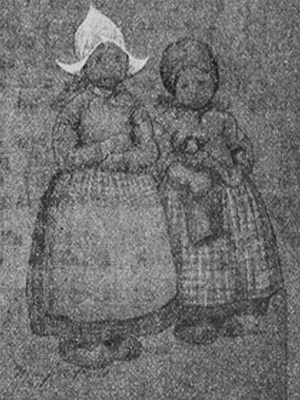
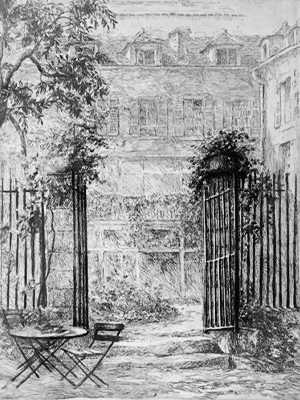
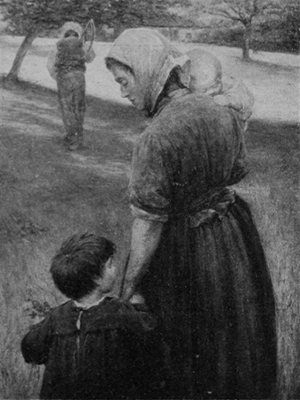
One last brief mention of the exhibition appeared in The Philadelphia Times on March 8, 1902, highlighting the efforts of Philadelphia natives (7).
- Blanche Dillaye, apparently chairman of the AWAA exhibition committee for 1902, exhibited “Nuit d’Eté” and her other painting was identified as “The Closing Day.”
- Elenore Plaisted Abbott, aside from designing the exhibition poster, showed a painting, “The Broken Toy.”
- May A. Post, studying in Paris on a one-year traveling scholarship from the Pennsylvania Academy of the Fine Arts, exhibited three sketches, “A Dutch Boy,” “A Dutch Girl,” and “Children of Volendam.” She was supposed to be visiting Italy later in March 1902.
- Mary Smyth Perkins, recipient of the William L. Elkins European Fellowship from the Philadelphia School of Design for Women, showed her three views of the Luxembourg Gardens.
1903
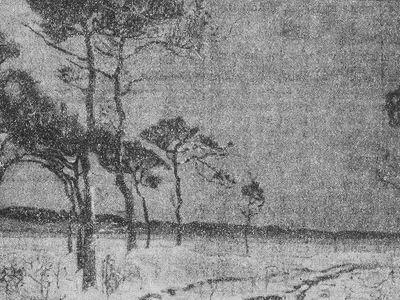
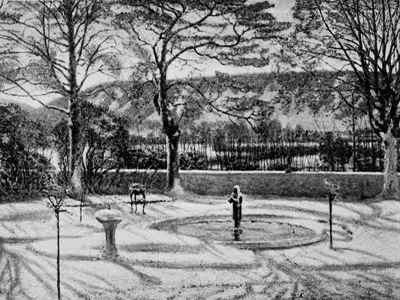
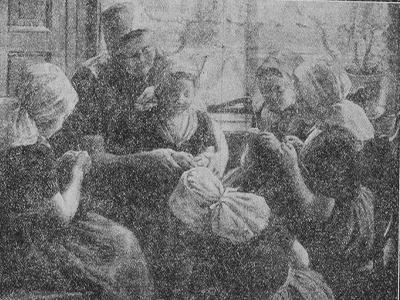
In 1903, the annual exhibition was held from February 21 to March 4 at the American Girls’ Art Club. The AWAA president for that year was Mary Fairchild MacMonnies, the vice president was Elisabeth Kruseman Van Elten, and the secretary was Caroline Minturn Hall.
A brief mention of the show was printed in The Baltimore Sun on February 22, 1903 (5). Sculptor Frederick MacMonnies was erroneously listed as the AWAA president for the year instead of his wife. Some of the artists who exhibited were:
- Florence Esté
- Eleanor Greatorex
- Jeannette Scott
- Elisabeth Kruseman Van Elten
Gil Blas also covered the exhibition on February 23, 1903. The only artist acknowledged for her work was "Mlle Pliffer," a misspelling of the name of sculptor Clare Pfeifer Garrett.
The New York Herald European edition once again published a front-page review of the AWAA show in its supplement on February 22, 1903. There was a slightly critical comment about the lighting in the exhibition space but the show itself had “little to find fault with” (Supplement 1). The reviewer particularly wished to call attention to the seriousness of the work on display, applauding the artists for avoiding the trap of trying merely to be “chic.”
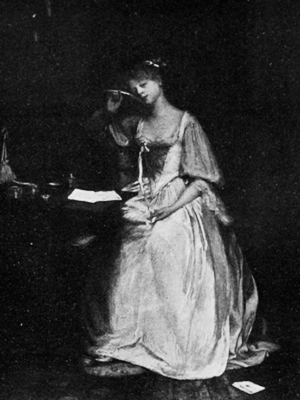
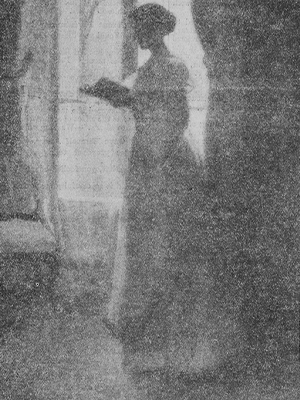
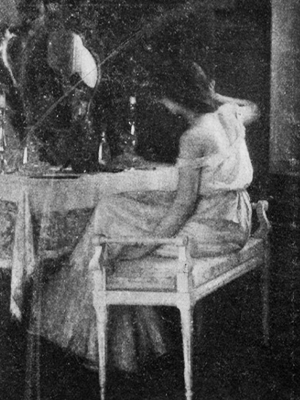
The 1903 exhibition jury included Eugene Vail, Julius Stewart, and S. Seymour Thomas, and the hanging committee, in charge of the placement of all the works in the show, was composed of artists Jeannette Scott, Imogen Coulter, and Mary C. Barringer. All told, 50 artists were represented in the exhibition by nearly 100 individual works.
- AWAA president Mary Fairchild MacMonnies exhibited a large winter scene, “La Neige,” depicting her home and garden in Giverny.
- Hung next to “La Neige” was a portrait sketch of a young woman reading near a window by Jeannette Scott. The reviewer considered it “the best thing of its kind” in the whole show.
- On the same wall, near the works by MacMonnies and Scott, were two paintings by Harriotte Teleaferro (misspelling of Taliaferro). Despite her status as a young female painter, the reviewer described her work as “virile,” praising her painting of a young peasant girl and a landscape.
- An artist identified only as “Miss Sands” is painter Ethel Sands, who exhibited “a deftly-executed interior” showing an old fireplace.
- The showpiece of the exhibition was a snowy landscape of fir trees by noted painter Florence Esté. According to the reviewer, “[…] it suggests no thing so much as some masterpiece from Japan, pervaded though it is with Occidental thought and sentiment.” Esté also exhibited a landscape of a mountain.
- Elizabeth Nourse, a frequent AWAA exhibitor, only sent one work to the 1903 show, a chalk study of two small children.
- Mrs. Ada[Irene] Congdon exhibited two Dutch paintings, one of an old woman boiling water in a kettle by the fire and another called “The Gray Day in Holland.”
- Mme. Millet [Geraldine Reed Millet] showed a pastel of a young girl seated on an armchair in a garden.
- Lena Qualley exhibited a studio interior featuring a seated young woman in a black dress.
- Eleanor Norcross, a Massachusetts artist known for her intricately painted interiors, exhibited one that included vibrant colors: a blue Oriental carpet, yellow flowers, and a polished wood floor.
- A. [Anna Hope] Hudson showed a landscape of a canal with trees leading to a stream. “The picture has a decided personal note that is original and pleasing.”
- Elsie Stuart Pattee exhibited several works, most notably a highly-detailed painting of a French farmhouse, a watercolor of the Biblical story of Christ and the broken water jar, and several miniatures.
- Eliza V. Haigh showed a Dutch interior described as a “solidly-painted scene.”
- Mary Shepard Greene exhibited a large three-quarter length portrait of a colonel in the U.S. Army.
- Painter Anita Sargent, cousin of John Singer Sargent, was praised for a landscape and for an interior of a granary featuring an old woman and a child.
- Alice Boner, supposedly “a young artist recently come from America,” exhibited a colorful sketch of a fountain in Luxembourg Garden with a view of the Panthéon in the background.
- “The Knitting Lesson,” an interior painting by Elisabeth Kruseman Van Elten, depicted five young ladies learning to knit under the tutelage of an older woman. It was considered to have excellent composition and was “extremely interesting.”
- Two watercolors were listed together as the best examples of the bunch: one of an Italian boy by Florence K. Upton and one of a country house and garden by Eleanor Greatorex.
- Caroline Minturn Hall showed three pastels that were “radiant.”
- Miniatures by M. [Margaret] Anna Watson, M. [Mathilde] de Cordoba, Harriet Hollowell, and Mrs. [Margaret] Spicer-Simpson were all mentioned as worthwhile.
- Drawings were also singled out for praise: Alice H. Barri’s two pencil drawings of musketeers; a pen and ink sketch of a young woman by Elizabeth Taylor; and two architectural studies by Rebecca Chase.
- Though no large sculptures were exhibited this year, two small busts by Katherine M. Cohen and two portrait medallions by Mrs. Paul D. [Mabel Harris] Conkling.
- The reviewer concluded by expressing interest in the work of Clare Pfeifer—she was going to exhibit a bas-relief portrait of Alice Boner but it had not yet arrived at the show.
Arsène Alexandre published a short review of the 1903 annual exhibition in Le Figaro on February 24, 1903. He praised portraits by Mary Shepard Greene, Lucy Lee Robbins, Susan Watkins, and Anna Elizabeth Klumpke. But the best work in the show, in his opinion, was Mary Fairchild Macmonnies’ “Effet de neige” which had an “extraordinary intensity” (translated from French, p. 5).
1904
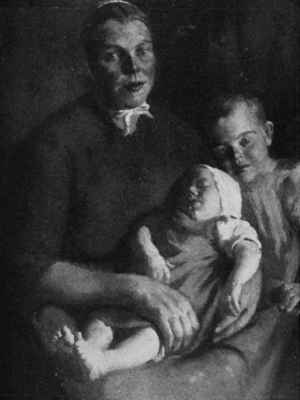
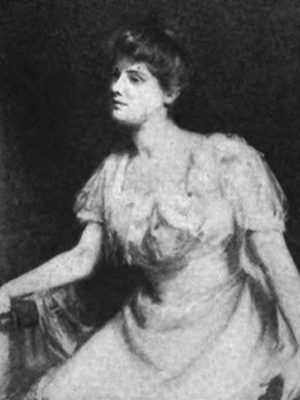
American painters Walter Gay, John Humphreys Johnston, and Edward Simmons formed the jury that selected 93 works (88 paintings, five sculptures) for the annual exhibition, open from February 20- March 2, 1904. AWAA leadership remained the same as in 1903: Mary Fairchild MacMonnies as president; Elisabeth Kruseman Van Elten as vice president; and Caroline Minturn Hall as secretary.
A review was published in The New York Times on March 6, 1904: "This year's exhibition was opened a couple of days ago in the Rue de Chevreuse, and is generally admitted to be an improvement on its predecessors. It contains, of course, examples of that pathetic striving after the unattainable which has ended in irremediable failure, but so do most picture galleries" (4).
Mercifully, the reviewer does not name those artists whose work he considers pathetic, but he does praise:
- Mrs. [Katherine Arthur] Behanna ("Trois tetes de vieillards" and "L'Avare")
- Mrs [Mabel] Conkling (sculpture)
- Miss [Caroline Minturn] Hall, secretary of the AWAA ("The Pines on a Hill")
- [Ella] Hergesheimer (miniature)
- Anna Hope Hudson ("Scene in New Jersey")
- Mrs. MacMonnies, ("The Doll's Tea Party," a painting of her two children on the terrace of the family's home in Giverny)
- Elizabeth Nourse, (painting of a deserted church in Brittany, drawing: "La petite soeur")
- Harriet Sophia Phillips
- Marion Powers
- Mrs [Sarah Center Whitney] Robinson (sculpture)
- Miss Van Helten [incorrect spelling for Elisabeth Kruseman Van Elten], (painting: "Un petit déjeuner au jardin" and aquarelle: "Two Is Company")
Victor Ducieu published a highly detailed French review of the two-week AWAA show in L'Art (147-149). He not only listed many of the artists but also the titles of their works on display.
- Alice H. Barri ("Trijn")
- Minerva J. Chapman ("Otay Mt. S. California")
- Althea Chase ("Mexican Pottery")
- Maria Daviess ("Etude de modele" and "Early Morning in the Luxembourg")
- [Mary] Estelle Dickson ("Jeune femme aux fleurs")
- Alida Ghirardelli ("Intérieur")
- May G. Hart ("Windy Day")
- Alma Hirsig (miniatures)
- Helen Kibbey ("Study of a Child's Head")
- Anna Lynch ("Jeune fille au chapeau rouge" - miniature)
- Alice Murphy (Dutch-like painting of young woman with fruits and carrots)
- Alice Blair Ring (painting of a young girl climbing a tree)
- Jean A. Robinson ("Vue des toits," "Intérieur d'église," "Study - young woman")
- Anita W. Sargent ("Soleil couchant a Barbizon")
- Alice Schille (aquarelle: "Yanneke," sketch: "Her children")
- Frances Quarles Thomason (3 works, "Luxembourg Gardens," "Out-Door Cafe," "Along the Quai")
- Anna Watson (miniatures)
- Adele Winckler (miniatures)
- Caroline S. Yardley ("Etude de portrait")
- Emilie Zeckwer ("Afternoon Tea at the American Girls Club," "The Capucine," "Memories of Italy")
A write-up of the exhibition was also published in The New York Herald European edition on February 21, 1904 (5). The reviewer, as usual, critiqued the poor lighting in the galleries but proclaimed the show “well worth seeing” and named a number of artists/works. Sadly, this review was not accompanied by images of the exhibition.
- Emilie Zeckwer, an artist who had not previously exhibited with the AWAA, was a “budding talent” whose “Afternoon Tea at the American Girls’ Club” was “very creditable.”
- Another new face, miniaturist Alma Hirsig of New York, showed two works that were “the best that have been exhibited at the club for many a long day.”
- The three invitées (artists who were invited to exhibit) were Elizabeth Nourse, Estelle Dickson, and Lucy Lee-Robbins. Nourse showed a painting of a chapel interior in Brittany as well as a drawing, “La Petite Soeur.” Dickson exhibited two paintings, “redolent of flowers and afternoon sunshine and sweet femininity all combined.” Lee-Robbins was represented by just one study in pastel.
- Mary Fairchild MacMonnies was accorded the place of honor “on the best-lighted wall,” where she exhibited a characteristic painting of a garden and porch featuring children, likely her own daughters, playing with dolls.
- Caroline Minturn Hall showed a number of landscapes in oil, prompting the reviewer to wonder why she had spent so much time in previous years working in pastel (seemingly a mistake).
- Minerva J. Chapman also exhibited a creditable landscape.
- Frances Thomason “manifests a talent all her own” in three small paintings, particularly “Outdoor Café” and “Along the Quai.”
- Ethel Sands, whom the reviewer erroneously declares a first-time AWAA exhibitor (she had already shown a painting at the 1903 show), exhibited a remarkable interior, featuring only an unmade bed in a sparse room with a chair, crucifix, and white walls.
- Jean A. Robinson, Ella Hergesheimer, and Helen Kibbey “contributed a personal note each of considerable interest.” It is unclear what the reviewer means here; perhaps they showed self-portraits or portraits of close family members?
- There were only 5 pieces of sculpture in the exhibition and they were contributed by two artists, Mabel Conkling and Sarah Robinson. Robinson is identified as a “disciple of Rodin, one of whom the master need not be ashamed.”
- The review also lists a number of artists without describing their works: Caroline S. Yardley, Adele Winckler, Anna Watson, Edna Hays Vosburgh, Isabel Vernon, Elisabeth Kruseman Van Elten, Florence K. Upton, Alice Schille, Anita W. Sargent, A. [Alice] Blair Ring, Marion Powers (“whose ‘Heirlooms’ are rather well done”), Harriet S. Philips, Eleanor Norcross, Alice Murphy, Alice Benton Jones, Anna Hope Hudson, Margarethe E. Hisser [misspelling for Heisser], Mrs. Mary G. Hart, Alida Ghirardelli, Mary Gay, Mamie Foggarty, Maria Davies [misspelling for Daviess], Mrs. Adairene Congdon, Alice H. Barri, Mrs. K. Arthur Behenna, Althea Chase, Lida Clark.
A brief article about painter Ella Hergesheimer appeared in the Pennsylvania newspaper The Morning Call on March 11, 1904. The article reports on Hergesheimer’s success in Paris, where she was studying thanks to a travel scholarship from the Pennsylvania Academy of the Fine Arts. Her three works in the AWAA exhibition are identified as: “Dutch Peasant Woman and Children,” “Miniature of Dutch Girl,” and “Italian Woman and Child” (8).
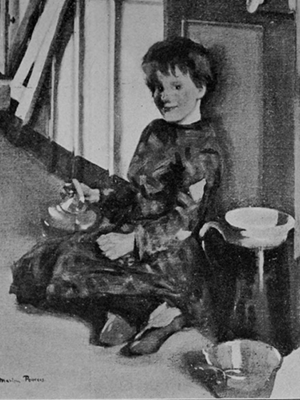
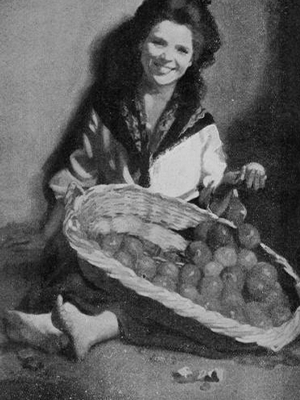
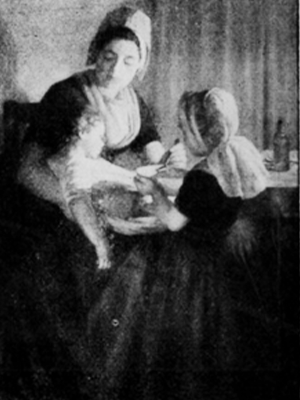
The official AWAA exhibition catalogue from 1904 definitively records which artists participated in the show and which of their works was featured but it is not illustrated. The catalogue is preserved at the Smithsonian. In the Painting section were:
- Alice H. Barri: two other pencil studies besides "Trijn."
- Mrs. K. Arthur Behenna: "Etudes" and "L'Avare."
- Minerva J. Chapman: a portrait study and "Otay Mt. S. California."
- Althea Chase: "Salambo," "After the Duel," and "Mexican Pottery."
- Lida Clark: "The Task."
- Adairene Vose Congdon: "An Interesting Story"
- Maria Daviess: "Early Morning in the Luxembourg," "Miniature. A Portrait Study," and "Miniature. Study of a Model."
- Estelle Dickson: "Jeune Femme aux Fleurs" and "A Summer's Idyll"
- Mamie Fogarty: a still life
- Mary Gay: "Mother and Baby"
- Alida Ghirardelli: "Black and Gold" and two interiors
- Caroline Minturn Hall: "The Cypresses," "The Pines on the Hill," "The Pines by the River"
- May G. Hart: "Orchard" and "Windy Day"
- Margarethe E. Heisser, three monotypes: "The Brook," "The Entrance to Hades," and "Sunset"
- Ella Hergesheimer: "Dutch Peasant Woman and Children, "Miniature of an Italian Girl," and "Miniature, Italian Woman and Child"
- Alma Hirsig, two miniatures
- Anna Hope Hudson, "Autumn Sketch, New Jersey" and "Sketch, England"
- Alice Benton Jones, "Le Pré" and "Les Cuivres"
- Helen Kibbey: "Study of a Child's Head," "Study in pencil," "Volendam Girl"
- Grace Hunter Leighton, an interior
- Anna Lynch, miniatures
- Mary Fairchild MacMonnies, "La Fête des Poupées" and "Etude de Femme Nue (miniature on ivory)"
- Alice Murphy: "At Rysoord," "Yanna," and "Pettinelle"
- Eleanor Norcross: "Au Louvre," and two interiors
- Elizabeth Nourse: "Chapelle de la Madeleine, à Penmar’ch (Finistère)" and "Drawing, La Petite Soeur"
- Harriet S. Phillips: "Dammerung" and "'1830'"
- Marion Powers, "Heirlooms" and "Alexina"
- Alice Blair Ring, "A Shady Nook"
- Lucy Lee-Robbins, "Daisy," a study in pastel
- Jean A. Robinson, "Housetops," "Church Interior," and "Study"
- Ethel Sands, a sketch and an interior
- Anita W. Sargent, "Heather, Forest of Fontainebleau," "Sunset at Barbizon," "Memory of St. Cloud"
- Alice Schille, "Yanneke," a study, and "Her Children"
- Frances Q. Thomason, "Luxembourg Gardens," "Out-Door Cafe," and "Along the Quai"
- Florence K. Upton, "Wind Clouds across the Heather-Dunes"
- Elisabeth Kruseman Van Elten, "Un Petit Dejéuner au jardin," "Milking Time (aquarelle)," and "Two Is Company (aquarelle)"
- Isabel Vernon, "The Japanese Print"
- Edna Hays Vosburgh, pencil sketch
- Anna Watson, miniatures
- Mrs. Adele Winckler, miniatures
- Caroline S. Yardley, two portrait studies and "Portrait of Miss Me C"
- Emilie Zeckwer, "Afternoon Tea at the American Girls' Club," "The Capucine" and "Memories of Italy"
There were just two sculptors: Mabel Conkling, who showed: "Sketch, Andromeda," "Portrait Bust" and "Bas-Relief, Portraits" and Sarah S. Robinson, represented by "Jeune Fille qui pleure" and "The Broken Wing."
1905
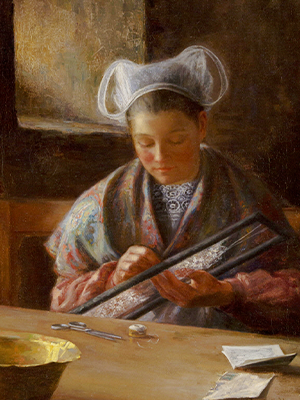
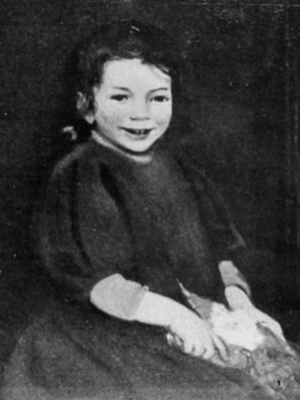
The New York Times briefly reported on a 1905 AWAA sketch exhibition in "Paintings by American Women" (7). Many of the works on display were landscapes. Notable exhibitors were:
- Miss Fergueson [Nancy Maybin Ferguson]
- Mary Green [Mary Shepard Greene]
- Miss Kibby [Helen Kibbey]
- Mrs. [Mary Fairchild] MacMonnies
- Elizabeth Nourse
- Miss Sargent [Anita W. Sargent]
- Mrs. [Janet] Scudder [note: Scudder never married]
- Miss Waters Bertha Mary Waters]
- Miss Wyman [Florence Wyman Ivins]
A magazine called The Index highlighted the annual AWAA exhibition in 1905 (28), acknowledging the three artists originally from the state of Indiana:
- Helen Goodwin (2 miniatures)
- Frances Goodwin (portrait bust)
- Janet Scudder (fountain)
The New York Herald European edition reported that the 1905 annual exhibition opened on February 18 and was set to close on March 4. The jury for that year’s show was larger than usual, consisting of artists Alexander Harrison, Henry S. Bisbing, Eugene Vail, Elizabeth Nourse, and Florence Esté. Around 65 works were on display, 60 paintings (in oil, watercolor, and pastel) and 5 sculptures.
- The reviewer deemed two works by Elizabeth Nourse among the best in the show: a Breton baby in a cradle and a peasant woman.
- A painting by Mary Fairchild MacMonnies, also “among the best efforts,” depicted a Normandy interior (10).
- Among the other exhibition highlights were: Anita Sargent’s portrait of a young woman; Helen Kibbey’s painting of children and nannies in Luxembourg Gardens; Emily Zwecker’s [misspelling of Zeckwer] picture of children wading in a stream; Caroline Minturn Hall’s view of a woodland valley; May G. Hart’s rendering of the Court of Fishes in the Alhambra; and Ella G. Hargsheimer’s [misspelling of Hergesheimer] portrait study.
- In no particular order, the reviewer also praised other works: “Galette Bretonne,” a picture of a girl making dough in a Breton kitchen, was unfortunately not attributed to a particular artist.
- Alice Blair Ring exhibited a girl walking in a wooded path with flowers.
- Martha Walter showed a number of works: three Italian scenes, a street in Capri, and Amalfi street scenes
- Emily L. Wyman showed the Val de Grace as well as a portrait.
- Emily Zeckwer showed another work, an old woman sewing in Brittany.
- Calthea Vivian exhibited a painting called “October Woods.”
- Florence Esté’s two works, a painting of a blossoming peach tree and some sort of design were “both in the impressionist style and are decidedly decorative.”
- Nancy Ferguson showed two views of Luxembourg Gardens.
- An artist identified only as H. Edwards exhibited a picture of a flower vendor.
- Mary Shepard Greene showed a pastel drawing.
- Elisabeth Harwood exhibited a painting entitled “Spring.”
- The miniatures were listed together: Anna Watson’s portrait of an old man; Mary Lyttleton Wyatt’s portrait of a little girl; Helen Goodwin’s unidentified portrait; and “an excellent portrait of a Frenchwoman” by Malote Bartleson.
- Sculptor Mary H. Webster showed the head of an old man. The great Janet Scudder exhibited a fountain with a boy, and Lucy Fairfield Perkins, a student of Rodin, showed two small statues “which have a good deal of merit.”
Another brief article, about painter Maria Daviess, was published in The Tennessean on March 6, 1905. It noted that Daviess (although her name in the article was spelled incorrectly as Davis) had exhibited three paintings at the recent AWAA show. Daviess had apparently been studying in Europe for the past two years, regularly visiting Brittany and other parts of France and Holland “to obtain material and local color” for her paintings. She was sharing an apartment in Paris with another American artist, Aileen Tillman, at the time (15).
1906
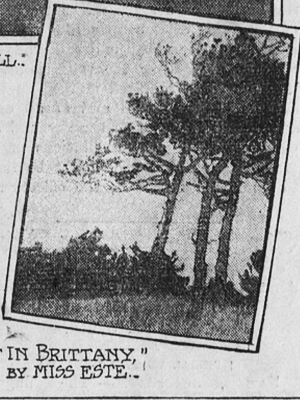
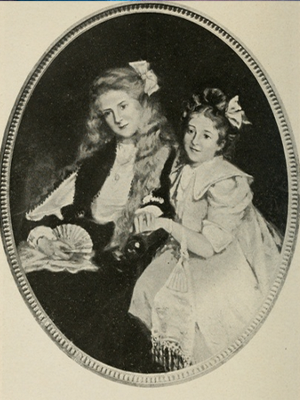
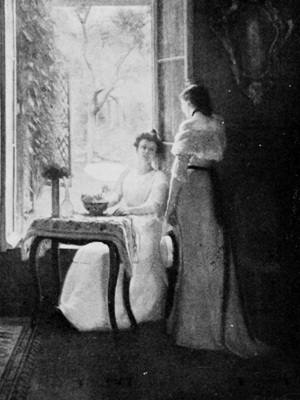
The annual exhibition was described on February 25, 1906 in The Chicago Daily Tribune (B1). Mary Fairchild MacMonnies and Florence Esté were invited to participate. Other artists, who submitted their work and were selected by the jury, included:
- Helen Kibbey Bruce
- Anita Sargent
- Adairene Vose Congdon
- Nancy Maybin Ferguson
- Alida Ghirardelli
- Caroline Minturn Hall
- Mrs. May G. Hart
- Margarethe Heisser
- Mme Francois Millet [Geraldine Reed Millet]
- Gertrude Partington
- Bertha Rockwell
- Frances Quarles Thomason
- Susan Watkins
The AWAA leadership for 1906 included president Anita Sargent, vice president Caroline Minturn Hall, and secretary Margarethe Heisser. According to the review in The New York Herald European edition, the exhibition jury was comprised of Walter Gay, Richard Miller, and Florence Esté, while the hanging committee included Mary Lyttleton Wyatt, Gertrude Sorver, and Catharine Carter Critcher. The exhibition featured around 50 paintings and a single sculpture (February 18, 1906, 3).
- The lone sculpture, by Mary H. Webster of Cincinnati, was a “well-moulded head” called “The Dreamer.”
- Florence Esté exhibited three color drawings of Brittany, fairly typical of her work. Many other artists in the show were inspired by Breton subjects as well.
- The other artist invited to exhibit “hors concours,” Mary Fairchild MacMonnies, showed two paintings of Giverny, also characteristic of her us
- Rhode Island native Caroline Minturn Hall exhibited six pictures, three of Brittany and three representing American scenes.
- Anita Sargent, from Boston, showed a painting called “Heather,” which captured the forests of Fontainebleau, near Barbizon. She also showed an interior that featured a portrait of her sister.
- May G. Hart was given a place of honor, as her painting “Chateau de Gaillard (Petits Andelys)” was hung very near the works of Florence Esté.
- Nancy Maybin Ferguson exhibited two paintings of Brussels, one a park view and the other of the church of St. Gudule.
- Frances Thomason showed three paintings, including one of Luxembourg Gardens, another favorite subject of AWAA artists.
- Mrs. Helen Bruce [the former Helen Kibbey] showed a picture of a young woman performing on a tightrope at a country fair.
- Bertha Rockwell exhibited two moonlight scenes.
- An artist named “Miss Kassen” exhibited the portrait of a Breton woman cleaning in her kitchen.
- San Francisco native Gertrude Partington exhibited a painting of Florence, featuring the Arno river and the Lungarno streets on the river.
- Mme. Francois Millet [Geraldine Reed Millet] exhibited portraits and garden scenes from her Barbizon home.
- Margarethe Heisser, originally from Minneapolis, had apparently studied quite a bit in Rome and showed a lovely painting of Villa Borghese and its balustraded gardens.
- Catherine Watkins’ painting “After the Rain” captured a forest in Brittany.
- Alida Ghirardelli was named as an exhibitor but her works were not identified.
- Finally, Mrs. Congdon [Adairene Vose Congdon] displayed “a first-class interior study.
1907
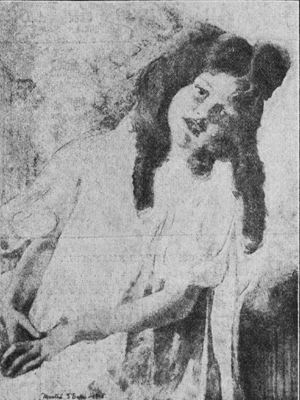
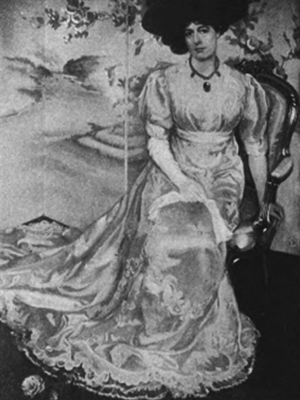
The AWAA exhibition opened at 4 rue de Chevreuse on February 16 and closed on March 2, 1907. The president for that year was Florence Esté and the vice president was Adairene Vose Congdon; the Club's directress, who was apparently involved in these exhibitions, was Jeannette T. Moffett. Esté, due to illness, did not exhibit in the show. As usual, The New York Herald European edition covered the show, publishing a review on February 18, 1907 (6). The number of works on display had increased to 81, up from the previous year, but the reviewer was careful to note that quantity did not dampen the quality of the art: “Vitality and progress are both discernible.” The jury was composed of Walter Gay, René Ménard, and René Prinet.
- The reviewer for this year wished to call particular attention to the drawings, etchings, and engravings of the exhibition, which traditionally are mentioned last. The four drawings of women by Anne Estelle Wright [a misidentification of Anne Estelle Rice] were especially good, as were nine color woodblock prints by Ethel Mars, and three drawings by the “fellow-worker” of Ethel Mars, her partner Maud H. Squire.
- Edna H. Vosburgh designed the exhibition poster, which was unfortunately not reprinted in the Herald’s article.
- Gertrude Partington exhibited three drypoint portraits, while Anne Goldthwaite exhibited two etchings which were “good in technique, but somewhat cold.”
- Ingeborg Andreason exhibited five pencil sketches, including some of babies’ heads.
- Frances Trumbull Lea and Virginia Wood also showed drawings, and Wood additionally exhibited a pastel “Portrait of Miss L.C.” as well as a painting, “Monday in Holland.”
- Bertha Rockwell exhibited two watercolors, “Twilight” and “Moonlight.”
- Grace Netter showed a watercolor called “When Ceres Comes.”
- S. [Sarah] E. Hawley presented two works, a view of Dordecht and another called simply “In Holland.”
- Teresa Cloud exhibited “Tete de Religieuse” which was thought to have character.
- Mary R. [Rogers] Williams exhibited four Italian scenes.
- Miniaturist Martha Baker showed two works, one which had won a bronze medal at the 1904 St. Louis Exposition. It was a portrait of a young girl, Rayna Simons of Chicago, daughter of Mr. and Mrs. Joseph Simons. (reproduced in the NYH article).
- Other miniaturists included Maria J. Strean, Sarah E. Cowan, and L. [Louise] Cameron Walter.
- The lone sculpture in the show was a “powerfully modeled portrait bust” of M. Belotzerpofski [sp?] by Myra Thompson.
- There was also a section of the exhibit devoted to objets d’art, in which Ingeborg Andreason displayed some jewelry and Bertha D. Herbert some opera-bags and card cases.
- Adairene Vose Congdon, AWAA vice president for 1907, showed two works, including “In Holland,” depicting an old peasant man with a pipe and his wife.
- Esther Hunt exhibited three portraits, including one of a Miss Balcom, another of a Miss Van Pelt, and the last of Miss Williams (possibly fellow artist Mary Rogers Williams?).
- Frances Trumbull Lea also showed two portraits and Anne Goldthwaite exhibited a painting called “The Red Book.”
- Catharine Carter Critcher exhibited the head of an old woman.
- Harriet Blackstone showed “The Old Blue Coat,” which could be considered a portrait and was “quite an original study.”
- A. [Alice] Worthington Ball, a painter from Baltimore, showed “Precious Heirlooms,” a canvas featuring a woman in a blue dress examining a cabinet full of objets d’art.
- E. [Ethel] Folsom exhibited two views of the Pont-Royal and an interior with “striking effects of light.”
- Miss Thomson [a misspelling of Frances Thomason] is “another keen observer of scenes in the French capital” who exhibited a number of sketches including, “Une Terrasse.”
- Maria J. Strean showed a well-regarded landscape, “The River at Pont-Aven.”
- Anna M. Richardson exhibited “Early Morning, Finistère” while Ingeborg Andreason showed “Spring Morning” and miniaturist Martha Baker showed “Hillside in Maine,” a study of clouds.
- Lucy Flannigan exhibited two marine views of Capri.
- Catherine Watkins showed “Environs de Pont-l’Abbé” while E. [Ethel] Fairfax Davenport was represented by an open air nude study.
- Margaret Anna Watson exhibited two works, including one painting of a fountain in Luxembourg Gardens.
- Florence Blood showed work “full of interest,” especially her painting “The Garden.”
- A large Dutch of scene by Alice Blair Ring, “Morning Sunshine,” was “very vigorous and natural” while Anna Woodward’s “Green Pitcher” was a “piece of solid painting.”
- Other exhibitors were: Clara Kretzinger, Julia S.L. Dwight (a still-life), Lucretia Spilman (a copper vessel), Helen M. Goodwin (a painting of roses), and Ida Hammond (a “strong Brittany landscape”).
1908
The 1908 AWAA exhibition, its fourteenth annual show, once again took place in late February-early March. The president for that year was Catharine Carter Critcher and the secretary was Jeannette T. Moffat. A brief mention of the annual exhibition by Arsène Alexandre appeared in Le Figaro on Feb. 17, 1908 (5-6). As usual, he listed those artists he deemed most successful in their efforts:
- Mme. Clements [Gabrielle de Veaux Clements]
- Mme. Critcher [Catherine Carter Critcher]
- Mme. Cronnan [Marie Cronin]
- Mme. Hunt [Maud Hunt Squire]
- Mme. Johansen [Myrtle Jean McLane Johansen]
- Mme. Mars [Ethel Mars, particularly her engravings]
- Mme. Nourse [Elizabeth Nourse]
- Mme. Rice [Anne Estelle Rice]
- Mme. Richardson [Anna M. Richardson, known for her landscapes]
The Baltimore Sun also included a notice about the exhibition (February 23, 1908, 5), praising artists:
- Esther Anna Hunt
- Ellen Stuart
- Catherine Watkins
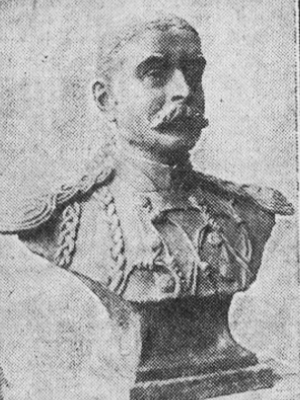
The New York Herald European edition published its review on February 22, 1908 and described many of the works displayed by the show’s 55 American women artists (6).
- There were just two pieces of sculpture in the 1908 exhibition: a plaster bust of M. David by Myra Thompson and a portrait bust of U.S. Army Captain Benjamen [sp?], who had recently been killed in action in the Philippines, by Frances Goodwin. This bust was to be erected in the cemetery on Long Island where Capt. Benjamen was interred.
- A large canvas by Texas painter Marie Cronin, “Quand Maman est sortie” showed a small child trying on her mother’s clothes, including a vibrant yellow silk dress. Cronin also exhibited “A Portrait of Miss Fisher.”
- AWAA president Catharine Carter Critcher also showed two prominent paintings in the main gallery room, “Margaret” and “A Portrait of Miss Van H--.”—both were deemed “among the best pieces of work in the exhibition.”
- M.G. MacLane Johansen, already successful in the Salon, showed two paintings, “Children’s Luncheon” and “Boy Drinking.”
- Another famous artist, Elizabeth Nourse, exhibited “a curious little Breton interior” called “Le Berceau.”
- Esther Hunt, another painter, showed three canvases, including “La Tanagra.”
- Sadie M. Hess showed two sketches of Etaples
- Anne Loo Matthews one painted view of Etaples, seemingly a popular subject with that year’s AWAA artists.
- Alice Worthington Ball exhibited a large painting of a peddler’s cart.
- Martha Baker’s painting “The Lake Front at Chicago” was described as a “typically American scene”
- E. Stone Bristol’s landscape was declared the best of her three works.
- A small painting by Ellen D. Stuart, “Windy Day at Paris-Plage,” was deemed to have merit.
- Frances Trumbull: Three pictures of houses in Rothenburg, near Nuremberg
- Estelle Rice: Four submisions of which “Roses” and “Un portrait” were considered the best.
The reviewer wasn’t very keen on most landscapes in the show but did praise Catherine Watkins' “A Village in Brittany.” She had been invited to exhibit “hors concours.”
- E.F. Folsom exhibited three works, the best of which was “L’Atelier de M.W.”
- All three of Margaret Anna Watson’s canvases were said to have “striking modernism”—best represented by her “The Mill at Montreuil.”
- Anna M. Richardson showed three outdoor paintings, “Gray Day,” “Sketch in Color,” and “Trépied.”
- Adairene Vose Congdon exhibited her work in an upstairs room at the Girls’ Art Club, a painting of “Une Bretonne” which had been admitted to the 1907 Salon des artistes français.
- Also upstairs was Anne Goldthwaite’s “The Rose Curtain,” and Alice Blair Ring’s “Borage and Poppies.”
- Helen M. Goodwin’s small still-life of fruit was considered very good as was Margaret L. Farrow’s painting, “Going Home,” featuring an unhappy flock of sheep in the evening.
- Though no miniatures were detailed in this review, a few notable drawings were mentioned: a colored drawing by Elizabeth Nourse, “Mère et Bébé,” the woodblock prints of Ethel Mars, and the colored etchings of Maud H. Squire.
1909
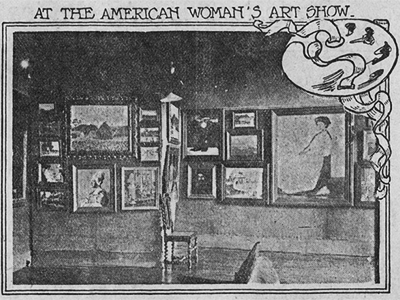
Town & Country noted that the annual exhibition was open from February 14 to March 1, 1909. There were also plans to host a summer salon at the Club for those who wanted to exhibit or sell their work before traveling (17). No artists' names were mentioned and it is unclear if the summer salon ever came to fruition. The 1909 exhibition was also reviewed in The Advance by Miss Kilbourne Cowles (404). Cowles praised two artists from Chicago:
- Martha Baker
- Clara Kretzinger
The San Francisco Call reported on November 21, 1909:
"The American Woman's Art association holds its annual exhibitions at the club, and they are ever the magnet for drawing big crowds to the quiet looking old building. The fourteenth [should be the fifteenth] exhibition of the kind has been held only lately, and in the course of the years that have passed many an American girl artist has had the delight of selling her first canvas and getting a start through attention directed to her work at one of these annual exhibits" (4).
A brief mention of the exhibition, described as "not particularly interesting," was published on March 13, 1909 in American Art News (5). Despite the lackluster review, a few artists were singled out for their work:
- Mathilde de Cordoba for "spirited American landscapes"
- Ethel Mars for "figure work"
- Kathleen McEnery for "figure work"
- Edith Hope Ogden for "a beautiful head in marble"
- Ellen Ravenscroft for "charming views of Versailles"
- Maud Squire for "amusing studies of the Latin Quarter"
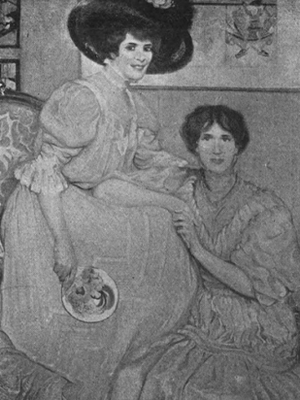
The New York Herald European edition published a review of the exhibition by an unnamed correspondent who visited on varnishing day. The review appeared on February 14, 1909 (6).
- Portraits were popular at the 1909 show. Three by Anne Goldthwaite were deemed to have attractive coloring though her portrait of Mlle. Banks had a “slight impression of stiffness.” Goldthwaite also exhibited a landscape, “Grez-sur-Loing.”
- Frances Trumbull Lea exhibited two portraits, one of the Misses Tilden and another showing Mrs. Howland-Jones, both “clever treatment[s].”
- M.W. [Margaret Wendell] Huntington was declared a talented colorist for her “The Fountain of Versailles” and “Arc de Triomphe du Carrousel.”
- “Fin du Jour” by Miss E. Blackburn was a “poetical composition.”
- Mathilde de Cordoba’s “Mists on the Hudson” and “Montagnes des Catskills” were “full of sentiment and imagination.”
- Helena Dunlap exhibited “Sunshine and Shadow.”
- Ethel Mars showed two paintings, “Concarneau” and “La Baie de Fouesnant.”
- Ida Hammond exhibited a painting called “Inspirations,” featuring a young girl playing the violoncello.
- Kathleen McEnery produced “A Castle in Spain,” notable for its good lighting.
- Eleanor Norcross, as usual, showed three exquisitely-detailed interiors: “Salle Louis XIV,” “Au Musée,” and “A Versailles.”
- Lilla Cabot Perry also exhibited three works, including “In Summer,” and “Portrait of J.C.G., Esq.”
- Ellen Ravenscroft exhibited six paintings, the best of which was “View from the Balcony of the Louvre.”
- Frances Thomason also showed several works, including a “cleverly executed interior.”
- Maud H. Squire had four café scenes in the Latin Quarter, “vivid in color and movement and true to life.”
- Jeanie Walter, a Baltimore native, was praised for her four unpretentious paintings, including “Sunset in Maryland.”
- Martha Baker exhibited two portraits and three paintings of the Luxembourg Gardens.
- Fannie Evans' “Study for Portrait” was also recognized.
- The last selection of paintings included an “Etude du Nu,” an interior, and two garden scenes by E.F. Folsom, as well as two works by Mary Fairchild MacMonnies, “The long Gallery, Louvre” and “Le Sommeil d’Hébé.”
- “A remarkably good collection of miniatures” included works by: Martha Baker, M.M. Cathcart, Fannie Evans, Anna W. Lea, I.B. Mapel, Heloise G. Redfield, Alice Blair Ring, Zelda Shanfield, Mary Lyttleton Wyatt, and Mary Fairchild MacMonnies.
- Colored etchings by Mathilde de Cordoba depicting children were praised as was “The Dance of the Seven Veils” by Frances T. Lea.
- Sculptures were exhibited by Edith Hope Ogden, Myra Thompson, and Clara Massee but “Sisters” by Sarah Morris Greene was considered worthy of special mention.
- There were also unidentified objets d’art by Virginia Canfield and Bertha Herbert.
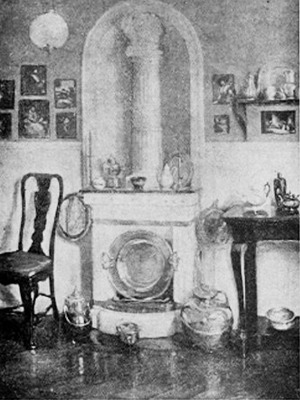
1910
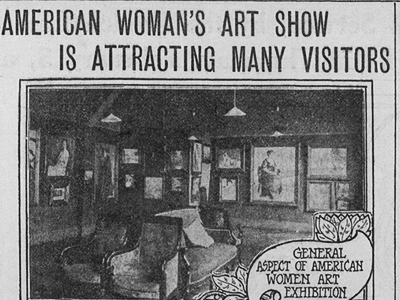
Robert Bacon, American ambassador to France, presided over the 1910 annual AWAA exhibition opening on February 12. Judges Walter Gay and two French artists selected one hundred and thirty works by American women. Anne Goldthwaite was president of AWAA for the year, while Maud Hunt Squire served as vice president and Jeannette T. Moffett was secretary/treasurer.
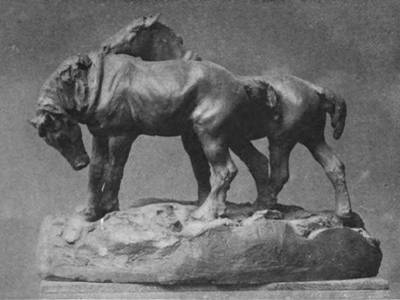
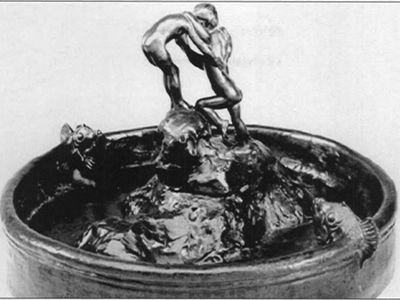
Artists featured in the show included:
- Amanda P. Austin (painting of "Breton Girl," two sketches: "Market Day at Pone-L'Abbe" and "St. Peter's, Rome," and a portrait bust)
- Constance Bigelow (portrait sketch of a young woman)
- E. Blackburn [possibly Josephine Eckler Blackburn]
- St. Clair Breckons
- Adairene Vose Congdon: "Ramparts of Montreuil-sur-Mer"
- Nell Coover
- Mildred Baynon Copeland: 3 works, "Portrait of Enid," study of a young woman: "Vanity," and an interior
- Cornelia Cowles
- Amalie Deady (watercolors)
- Carrie E. Decker
- Lucille Douglass
- Elizabeth Edmond ("The Dreamer," sculpture)
- Marian Frolich [incorrect spelling for Maren Froelich] ("Robe Chinoise")
- Anne Goldthwaite (an interior and a portrait of Mrs. Clifford Lippman)
- Helen Goodwin (miniatures)
- Nina Rose Hartwell
- Grace Mott Johnson (study of "Percheron Horses," sculpture
- Katherine Kimball (etchings of three ancient pieces of architecture and an old barge)
- Frances Lea (watercolors of Old World German towns)
- Mrs. A.W. Lea [Anna W. Lea] (miniature)
- Janet Lippman
- Florence Lucius (portrait bust)
- Alice M. Ludlum (enameled bowl)
- Florence Lundborg (3 sketches of Luxembourg Gardens and a decorative panel with a group of cypresses)
- Ethel Mars (colored sketch of the entrance to a coal mine and several Paris scenes)
- Kathleen McEnery (3 works, "La Seine Vue de la Tour-Eiffel," "Petit Luxembourg," and an untitled canvas)
- Belle McMurthy [incorrect spelling for Belle McMurtry] (hand-bound book)
- Maude Murray (three exterior scenes near Etel)
- Emma Alice Nordell
- H. Joan Osborne (miniature portrait of a young man)
- Hulda Parton ("Killarney Roses")
- Carolyn L. Peck
- Anne Estelle Rice (3 watercolors, 2 of seaside scenes)
- Anna Richardson ("Les dunes a Etaples," "Rainy day at Imptie," and "Etude")
- A. L. Sawyer [probably Amy Sawyer]
- Zelda Shanfield (miniatures)
- Lindsey Sterling (portrait bust)
- Maud Squire (vivid color etchings of Paris, especially interior of Casino at Montmartre, music hall, and "fete foraine")
- Marguerite Thompson ("Lady with Shawl")
- Myra Thompson (portrait bust)
- Marion Tooker (5 sketches, including a few cafe studies and "A Corner of Rouen")
- Grace Uhl ("Study of a Girl")
- A. Walker [Jessie A. Walker] (landscape etchings)
- W. Walker [Wilhelmina Walker] ("Sunrise on a Misty Morning" and "Bridge at Grey")
- Catherine Watkins ("Beech Trees in Brittany")
- Anna Watson (picture of crooked trees and miniature "Portrait of Mme C.)
- Mary Wesselhoeft (watercolors and sketches: figures copied from the west door of Chartres Cathedral and washerwomen of Chartres)
- Mary Wyant [incorrect spelling for Mary Lyttleton Wyatt] (miniature portraits of Mrs. Whitelaw Reid and Mme X., and a study of Manon)
The French press covered the exhibition, with a small review published in La chronique des arts et de la curiosité on March 5, 1910 (75).
- Minerva J. Chapman is called out for her miniature of a musician
- Alice McClure (incorrectly listed as Alice Clure) is praised for her paintings of two child models (Antoinette and Jeanne), including her use of color and her women's figures.
- Mlle E-D. Pattle (should be Elsie Dodge Pattee), for watercolors and an Oriental miniature,
- Alice Morgan Wright for a clay sculpture of a small group, "Springtime."
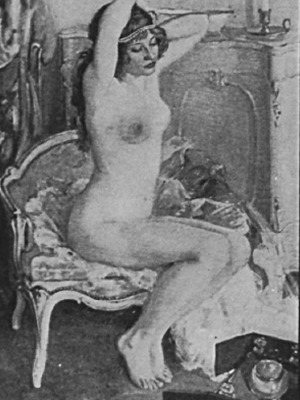
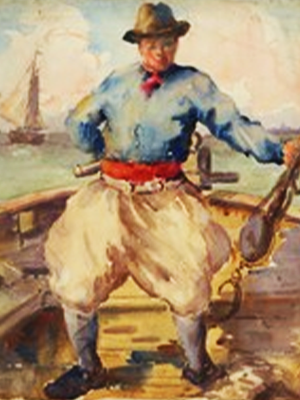
The New York Herald European edition of course published a detailed review of the show on February 13, 1910 (7). The works on display included paintings, watercolors, miniatures, drawings, etchings, sculpture, and objets d’art.
- Anna M. Richardson’s three paintings were “refreshing.” Mildred B. Copeland also showed three works, including an interior, “Portrait of Enid,” and “Vanité.” Anne Goldthwaite’s portrait of Mrs. Clifford Lipman, in spite of its “slight hardness of lines” was still noteworthy. Goldthwaite also showed an interior of a young woman daydreaming over her open book.
- More paintings were praised: Adairene Vose Congdon’s “Ramparts sur Montreuil-sur-Mer,” Hulda Parton’s “Killarney Roses,” Kathleen McEnery’s “La Seine, vue de la Tour Eiffel” and “Petit Luxembourg,” Wilhelmina Walker’s “Bridge at Grey” and “Sunrise, Misty Morning.”
- Two portraits of children by Alice McClure, “Antoinette” and “Jeanne” as well as her view of the Luxembourg Gardens and “Sur le Quai” were all praised.
- Amanda P. Austin had three of her works mentioned for their merit: “Breton Girl,” “Market Day at Pont-l’Abbé,” and St. Peter’s, Rome.”
- The two Fresno natives, Maren Froelich and Marguerite Thompson were both acknowledged as deserving notice- Froelich’s “Robe Chinoise” and Thompson’s “Lady with Shawl.” A portrait sketch of a young woman by Constance Bigelow and “Study of a Girl” by Grace Uhl were also described in this section.
- “Beech Trees in Brittany” by Catherine W. Watkins was “admirably executed and remarkable for its intensity of coloring.” Florence Lundborg showed three views of Luxembourg Gardens and a decorative panel featuring cypress trees. There were also five Impressionist sketches by Marion Farwell Tooker, including some café studies and “A Corner of Rouen.”
- Frances T. Lea’s watercolors depicted “picturesque views of Old-World German towns.” Anne Estelle Rice exhibited three outdoor sketches, two of which were seaside scenes. Mary F. Wesselhoeft showed sketches of Chartres, including figures copied from the Cathedral’s west door and washerwomen.
- Etchings by Maud Hunt Squire were “clever,” capturing scenes from the ‘fete foraine’ and the Casino at Montmartre. Landscape etchings by Katharine Kimball and J. Aitcheson Walker were also acknowledged.
- Miniatures “make a good show” and the artists singled out were: Minerva J. Chapman, Helen M. Goodwin, H. Joan Osborne, E.D. Pattee, Zelda Shanfield, M.A. Watson, Mary Lyttleton Wyatt, and Anna W. Lea.
- The sculpture section was larger than in past years, including works by Amanda P. Austin, Elizabeth Edmond, Grace Mott Johnson, Florence G. Lucius, Lindsey M. Sterling, Myra Thompson and Alice Morgan Wright.
- The two objets d’art that were recognized by the Herald’s reviewer were a “beautifully-composed enameled bowl” by Alice M. Ludlum and a “tastefully hand-bound book” by Belle S. McMurtry.
- Other exhibitors were: Cornelia Cowles, Carrie E. Decker, Nina Rose Hartwell, Mrs. Clifford Lipman, Maude Murray, C.L. Peck, E. Blackburn, Nell Coover, Emma Alice Nordell Parker, St. Clair Breckons, Amalie B. Deady, Lucile Douglas, and Amy L. Sawyer.
1911
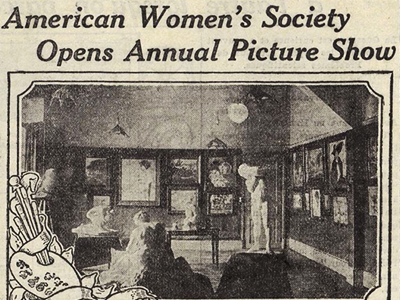
The New York Times review of the annual AWAA exhibition, published on Sunday, February 19, 1911, remarks on the trend toward Impressionism at the well-attended opening: "The newer impressionism runs riot at the annual exhibition of the American Women's Art Association, which opened to-night in the Rue de Chevreuse, with the usual grand reception, attended by the elite of the American colony" (C2). The reviewer also notes the increase in works of sculpture, acknowledging pieces by:
- Elizabeth Edmond
- Marion Lassey
- Florence Lucius
- Alice Morgan Wright
Artists mentioned by name were:
- St. Clair Breckons
- Miss Buell [Mabel Buell] (painting)
- Miss Burraye [incorrect spelling for Mildred Burrage] ("decorative garden scene flooded with sunlight")
- Adairene Vose Congdon ("A Forest in Brittany")
- Miss Cotton
- Fannie E. Duvall (two landscapes)
- Nina Rosabel Hartwell (inspired by Cazin)
- Frances Lea (painting)
- Ethel Mars (“ultra-modern portrait of artist friend, Miss McLure of Buffalo”)
- Miss McLure (four neo-Impressionist canvases)
- Florence Minard
- Ethel Moore
- Maud Hunt Squire (four watercolors of cafe life)
- Miss Uhl [Grace Uhl]
- Emily Burling Waite (place of honor at the exhibition for her two portraits)
- Catherine Watkins (street scene in Belgium called "To Vespers")
- Constance Bigelow Williston (influenced by artist Henri Martin)
Other sources indicate that Frances Hodgkins, a New Zealand artist appointed as the first female instructor at the Academie Colarossi, also exhibited in the 1911 show (RH archives).
According to The New York Herald European edition (February 19, 1911, 6), the exhibit was open daily from two pm to six pm and a string band provided entertainment on varnishing day. The opening was on February 18 and the closing was on March 2, 1911. Artists listed by name included:
- Constance Bigelow (a portrait of a young woman and 2 landscapes: "Woodland," "Summer Garden")
- Mildred Burridge [misspelling of Burrage] ("The Rose Garden")
- Mildred B. Copeland ("Portraits of Mrs. Davis and her Daughter")
- Adairene Vose Congdon (landscape)
- Miss Cotton (portrait of a young girl)
- Lucille Douglass (4 water-colors)
- Fannie Duvall (2 landscapes: "L'Oise, Auvers," a country road)
- Ethel Folsom (3 interiors)
- Anne Goldthwaite (2 portraits, one of a German girl, the other of Mrs. A---; 2 landscapes, "The Path By the Sea, Brittany," "Grez, near Fontainebleau"
- Nina Rose Hartwell ("A Farm Scene," "A Village Street")
- Lavinia Kelly (miniatures)
- Louise Osgood Koopman (portrait of a girl)
- Miss F. Lunter [misspelling of Florence Lundborg] ("The Blue Bridge, Vallendam")
- Ethel Mars (2 portraits of women)
- Alice McLure (2 still lifes, one with the branch of a flowering eucalyptus)
- Florence Minard ("Studio Scene," of women students with a model, "Theatre Scene")
- Jeanne Payne (miniature)
- Lilla Cabot Perry (2 water-color Spanish studies)
- Marion Holden Pope ("Girl in Garden")
- Hope Smith (a painting of Chartres Cathedral by night)
- Maud Squire (4 studies of music-hall and café types)
- Marguerite Thompson ("Bruges by Night," "Bruges by Day")
- Grace Uhl ("Rose-Garden," "The Gossipers")
- Emily Burling Waite (full-length portrait of a young girl and portrait of a young woman seated)
- Miss Walker (a portrait of a young girl and "Peasants on the Beach")
- Catherine Watkins (Dutch village street)
- Elizabeth Watson (picture of a girl picking flowers)
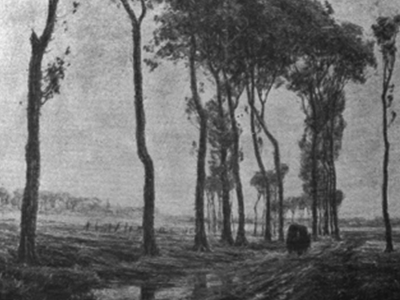
1912
According to the New-York Tribune, the 1912 AWAA exhibition featured loans of paintings, drawings, and sculptures by esteemed American and European artists. The show was organized by the Advisory Board of American Women, which included: Elisabeth Mills Reid (president); Mrs. Myron T. Herrick, wife of the American ambassador to France (vice president); Mrs. Robert Blick; Mrs. Stanford White; Mrs. Edward Tuck; Mrs. Charles Laurence; Mrs. George Munroe; Mrs. Henry Ridgway; Mrs. Hamilton Russell; Mrs. Fitzhugh Whitehouse; and Mrs. Walter Gay (December 15, 1912, 9).
The 1912 exhibition featured 200 loaned works, of which eight were sent by the Luxembourg Museum, including three portraits by John Singer Sargent (one of Mrs. Edward Boit, and another of his friend Jacques Blanche), as well as three watercolors by Whistler. Other major artists including Auguste Rodin had also been invited to exhibit.
The show, curated by George Howland, was favorably reviewed in The New York Times, which documented its popularity in the American colony: "the great success with which it is attended is striking proof of the activity of American students in Paris." (C2). Unlike the AWAA exhibitions of previous years, this show focused entirely on established, successful artists and excluded art students. Only a few renowned American women participated in this exhibition: Florence Esté, Elizabeth Nourse, and Janet Scudder.
1913
There were two major AWAA exhibitions at 4 rue de Chevreuse in 1913. The first show, the eighteenth annual exhibition, opened on February 1, 1913 and closed on February 16. It included 152 paintings and 51 sculptures. Ninety submissions were rejected.
The jury was composed of:
For paintings:
- Walter Gay
- Henri Martin
- Mr. Desvalières
For sculpture:
- Injalbert
- Paul W. Bartlett
There was a serious competition for the 1,000 franc prize offered by Elisabeth Mills Reid to the best painting. Given the quality of the artwork on display, the painting prize was ultimately shared by four women: Florence Esté, Elizabeth Nourse, Eleanor Norcross, and Anne Goldthwaite. There was also a sculpture prize, awarded to Malvina Hoffman, with honorable mention going to Olga Popoff.
Ambassador Myron T. Herrick and his wife attended the opening and he read the names of the prize winners to the assembled crowd. A detailed review of the February show appeared in The New York Herald European edition on February 2, describing the best works and the artists who produced them (3).
Florence Esté’s “La Fin d’un Beau Jour” had “heroic proportions” and was considered by the reviewer one of Esté’s best paintings ever. Elizabeth Nourse’s “La Bonne Ménagère” was “an attractive ‘homey’ picture” while Eleanor Norcross’ “Porcelaine de Vincennes” was said to have earned her the top prize. Norcross also showed another painting, “Porcelaine de la Révolution.” Fellow winner Anne Goldthwaite exhibited six portrait sketches, one of Dr. George Grafton Wilson.
Other paintings that were praised included:
- Mildred Baynon Copeland’s “Reflection,” which was considered “especially pleasing.” She exhibited two other paintings as well.
- “L’ombrelle jaune” by Juliette B. Nichols
- Mary Franklin’s painting of a scene in Tunis
- A Venetian painting by Anna M. Richardson, “Après-Midi,” deemed “one of the best in the collection.”
- Minerva J. Chapman’s oil painting, “Petit Déjeuner”
- Elizabeth Skinner’s “The House—A Memory”
- Edith Sterchi’s “Japanese Sash” [her first name is actually Eda]
- “Pont Neuf” by Ethel F. Folsom
- “Suzanne” by Constance Bigelow
- Hilda Grossman’s “The Wardrobe”
- “Portrait of Miss H” by Laetitia Herr
- “The Circus Parade” by Ethel Poyntell Canby, featuring animals from Noah’s Ark “in Nurseryland”
- Frances Q. Thomason exhibited several paintings but her picture of a woman in blue was called the best.
- Catherine Watkins, Elizabeth A. Watson, and Clara Rossman Saunders were also featured in the painting section
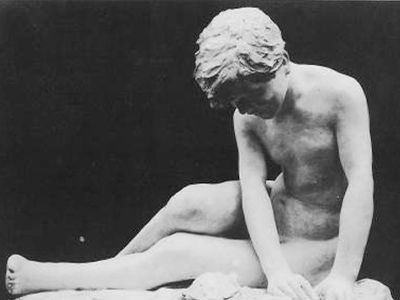
Malvina Hoffman’s prize-winning sculpture was “Danseuse Russe,” featuring two Russian dancers in bronze. The honorable mention went to Olga Popoff for her “Etude d’Homme.” Works by Jennie Collin and May Elizabeth Cook as well as Alice Morgan Wright’s “Enfant qui pleure” were “particularly worthy of notice.” Other sculptors in the exhibition included: Elizabeth Edmond, Ethel Mars, Eugenia Shonnard, Marie Louise Brent, and Caroline Risque.
Minerva Chapman had a group of “excellent miniatures” on display, while Jane Mumford’s miniatures of Dutch peasants were “attracting especially favorable attention.” Helen Cruikshank, Dorothy Betts, and Mary Lyttleton Wyatt were the other miniaturists named in the review.
Color prints of flower studies by Edna Boies Hopkins, especially her “Fuchsias,” were “notably attractive.” Two color drawings by Maud H. Squire, “Etudiant” and “Terrasse de Café” were also singled out. Ethel Pennewill Brown’s etchings were considered among the best in that section, particularly her travel scenes of London, Venice, and Swiss towns. Nell Coover’s etchings were also mentioned, but no specific works were highlighted.
Lastly, the best watercolors in the show were those of Winifred Bosworth, Jane Peterson, Henriette Amiard Oberteuffer, and Clara Rossman Saunders.
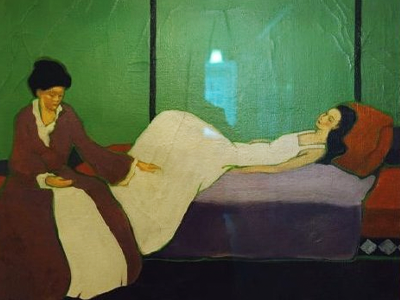
Later that year, another large exhibition was mounted at the Girls’ Art Club, though it may not have been installed under the auspices of the AWAA. American Art News covered the second show’s opening, which was once again presided over by Ambassador Myron T. Herrick on December 5, 1913 (5).
Winners of the exhibition competition were:
- Ethel Poyntell Canby: honorable mention for etchings
- Ada Gilmore: honorable mention for watercolors
- Bertha Houser: honorable mention for for drawings
- Edna Boies Hopkins: honorable mention for woodcuts
- Jane Peterson: Received the 500frs. prize from Elisabeth Mills Reid for her watercolor sketch, "Boats"
- Maud Squire: honorable mention for pastels
- Pamela Vinton-Strunz: honorable mention for miniatures
Three exhibitors did not participate in the competition, and were designated as "Hors Concours":
- Elizabeth Nourse
- Florence Esté
- Anne Goldthwaite
Exhibitors of watercolors, etchings, woodcuts included:
- Nell Coover
- Mathilde de Cordoba
- Blondelle Malone
- Mrs. H. Amiard Oberteuffer
- Margaret Patterson
- Frances Rogers
- Louise Venable
- L. Hazlehurst Vintors [incorrect spelling for Lillian Hazlehurst Vinton]
- Ethel Wars [incorrect spelling for Ethel Mars]
Exhibitors of miniatures:
- Minerva Chapman
- Bertha Coolidge
- Theodora Larsk [incorrect spelling for Theodora Larsh]
- Katherine McIntire
- Jane Mumford
- Viola Steele
- Mary Lyttleton Wyatt
The review concluded by acknowledging that the exhibition "has reached a high standard of excellence this year." It also noted an upcoming exhibition of oil paintings at the Club in February 1914 (likely the AWAA annual show) and one of sculpture and "objets d'art" in March 1914.
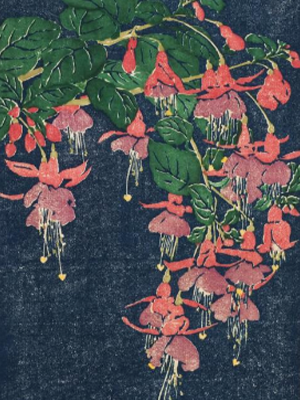
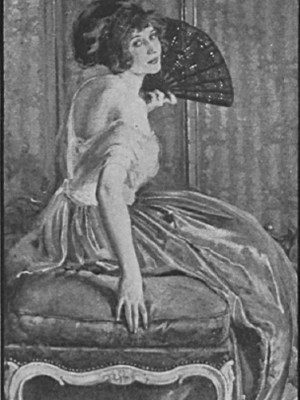
The review published on December 6, 1913 in The New York Herald European edition sheds light on the many artists who exhibited and the works that earned them recognition (2). The reviewer remarks that “there is an absence of any sign of an extreme movement,” alluding to the prevalence of modernism, Fauvism, and the shift toward abstraction in the rest of the art world.
Unsurprisingly, the honorable mention artists were listed first: Jane Peterson, who won the 500 franc first prize from Mrs. Reid for two watercolors; Ada Gilmore, for her three watercolors; Maud H. Squire, for pastels and scenes from Brittany and Chartres; Bertha Houser, honorable mention for drawings; Edna Boies Hopkins, for 10 woodcut studies of flowers; Ethel Poyntell Canby for etchings; and Pamela Vinton Strunz for her two miniature paintings.
The “hors concours” artists were listed next: Florence Esté one large decorative painting and three smaller sketches. Elizabeth Nourse showed nine pastels, with her “characteristic studies of mothers and babies being especially pleasing.” Anne Goldthwaite exhibited four sketches “in the modern movement” but they were clearly not so modern as to alienate the reviewer.
Other exhibitors were listed in no particular order. Laura M. McKey was commended for her two sketches of an Italian village and a street. Mrs. Frances Maroney [the former Frances Trumbull Lea] exhibited two sketches and two studies. Eda Sterchi’s Venetian watercolors “command attention” as do studies by Lora Hyde. Lillian Hazlehurst Vinton, the sister of Pamela Vinton Strunz, showed a Tours street scene and two portrait heads.
Nell Coover exhibited five colored etchings of children. Her “Enfant au Bain” was reportedly the work of art sold at the exhibition. Ethel Mars showed a group of decorative woodcuts, Jessie Aitcheson [Walker] showed three studies, and Elizabeth Curtis some “good drawings.”
The miniaturists were praised as a group and many were named: Minerva J. Chapman; Mary Lyttleton Wyatt; Bertha Coolidge; Theodora Larsh; “Miss Dreyfous” [probably Isidora C. Dreyfus]; Mrs. Jessie Long Stilinger; Viola Steele; Katherine McIntire; Mrs. John Magie; Jane Jarvis Mumford; Jeanne Payne; Eva Springer.
One last group of exhibitors was listed together: Mrs. Blanche von Daur, who showed a Venetian scene; Adele R. Brooks; Mary A.L. Burton; Margaret Chapin; Florence Choate; Doris Gernon; Margaret L. Goldschmidt; Blondelle Malone; Dora L. Murdock; Henriette Amiard Oberteuffer; Elise Paulin; Mrs. Pinhey [Amy Victorine Putnam Pinhey]; Hannah Rhett; Frances Rogers; Phebe Ropes; Hattie Saussy; Emily Travis; Marietta Van de Verg; L. [Louise] Venable; Helen Watkinson; Ethel Pennewill Brown; Mathilde de Cordoba; T. Hawley [probably Theodosia Hawley]; Margaret Patterson; and Gladys G. Young.
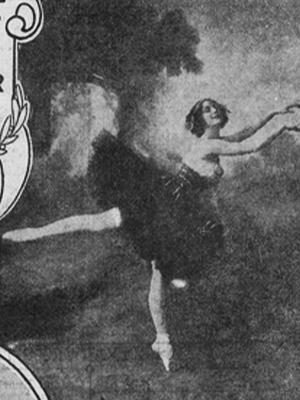
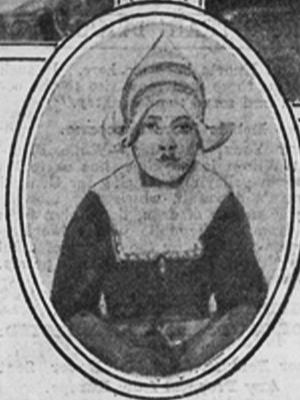
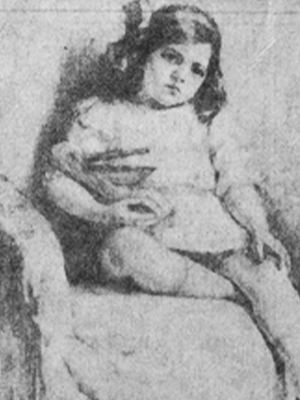
Just one day after the Herald’s review of the December exhibition, another article focusing on the various miniature painters featured in the show appeared on December 7, 1913 (2). Based on interviews with a number of artists, this article details the lives and works of American miniaturists in Paris.
Mary Lyttleton Wyatt and Minerva J. Chapman are identified as two of the more senior miniaturists in the American colony. Wyatt, originally from Baltimore, worked in a studio at 246 Boulevard Raspail and had been in Paris for nearly a decade. She exhibited in the Salon des artistes français at least nine times and was a member of the French Society of Miniature Painters. By 1913, Wyatt was also working as a teacher and had carved out a niche for herself in painting miniature portraits of wealthy society women, including Elisabeth Mills Reid and Emma Eames Gogorza, an American soprano. The Gogorza portrait and six others by Wyatt were on view at the AWAA show. Minerva Chapman’s studio was located at 9 rue Falguière in 1913 but she had been in Paris, according to the Herald, for twenty-seven years. Miniature painting was a more recent hobby for Chapman, taken up only about ten years earlier. An associate of the Société nationale des Beaux-Arts, Chapman frequently exhibited her work at the Salon des Beaux-Arts and with the AWAA. At the December 1913 show Chapman showed seven miniature portraits, including one of Mrs. David Kimball and her two daughters.
Mrs. Richard Miller [the former Harriette Adams] also exhibited at the 1913 AWAA show. She had apparently taken up miniature painting around 1910 and was a student of Mary Lyttleton Wyatt. The article states unequivocally that she is an artist in her own right: “It is not necessary for Mrs. Miller to rest upon her husband’s reputation as a painter. Her work can easily stand on its own.”
A newer miniaturist on the scene in Paris was Theodora Larsh. She summered in Etaples in 1913 and then moved to Paris in the fall. Larsh had been a frequent exhibitor of miniatures in the United States, where she said that interest in miniatures on ivory was higher than in France. Her miniature of Russian dancer Anna Pavlova and several other works were exhibited at the AWAA show. One hallmark of Larsh’s skill was her speed- she had apparently impressed many artists by producing a detailed and skilled miniature portrait of her grandfather in just an hour and a half. Larsh’s goal was to paint “the great men of her day” and she intended to return to America to start there.
Though she had been studying miniature painting for eight years, another recent arrival in Paris was artist Viola Steele. Having exhibited with the American Society of Miniature Painters in New York and at shows in Philadelphia, Chicago, and other major cities, Steele’s first Paris opportunity came with the 1913 AWAA exhibition.
Bertha Coolidge, originally from Boston and a friend of noted New England miniaturist Laura Coombs Hills, worked in a studio at 216 Boulevard Raspail. Coolidge, like many artists, did not exclusively produce miniatures, and had been a frequent exhibitor in the United States, including a solo show at the Copley Gallery in Boston. Though she was exhibiting only miniatures at the December 1913 AWAA show, Coolidge had spent the summer and fall in Moret-sur-Loing working on large-scale paintings.
Jeanne Payne, an artist studying in Paris since 1910, worked in a studio at 72 rue Notre-Dame-des-Champs. She exhibited both miniatures and larger paintings at the Salon des artistes français several times and showed Venetian watercolors as well as miniatures at the December AWAA exhibition.
Jane Mumford, a pupil of Richard Miller for at least four years, exhibited a group of miniatures at the Girls’ Art Club show, including one of singer Hilda Wierum. Mumford also worked in oils and produced etchings. Jessie Long Stillinger, a painter originally from Indiana, had a studio at 16 rue de la Grande-Chaumière and “expects to remain in Paris indefinitely.” She showed two miniatures at the AWAA exhibition: a nude and a child’s head. Eva Springer, another recent arrival in Paris, Miss Van Trump [Rebecca Newbold Van Trump] who worked at 5 rue Nouvelle Stanislas, and Pamela Vinton Strunz of Dresden, were the final miniaturists named in the article.
1914
A solo exhibition in January by Blondelle Malone was covered by L. De Cremone for Le Figaro (6). Another article in American Art News reported that Malone exhibited more than 100 paintings and watercolors, representing her work over the past 2-3 years: "She has considerable sense of color, and her watercolors are particularly attractive. Among the paintings the snow scenes may be specially mentioned (5).
The AWAA oil painting exhibition opened on February 21, 1914, with Ambassador Myron T. Herrick giving his customary opening remarks; it would close on March 8. The jury included Lucien Simon, René X. Prinet, and Georges Desvallières, while the hanging committee was comprised of Edna Boies Hopkins, Ethel Mars, and Maud Hunt Squire. Elisabeth Mills Reid offered two prizes: first prize of 1,000 francs to Grace Hill Turnbull for her painting, “Twilight,” featuring a mother holding a child sleeping on her shoulder. The second prize, 250 francs, went to Ethel Poyntell Canby for “Fleurs sur le Piano.” Canby also exhibited four other paintings. which were considered very good.
The New York Herald European edition published its lengthy review of the show on February 22, 1914 (2). After announcing the prize winners, the review described the many paintings worthy of merit:
- Helena Dunlap showed three paintings, “rich in color and sunlight.”
- Grace Ravlin exhibited three Tangiers scenes, including “An Arab Market.”
- Catherine Watkins, known for her paintings of trees, showed three such works called “Corners in England” as well as one large-scale canvas.
- Minerva Chapman showed three paintings, including a still life, and Wilhelmina Walker exhibited “Empty Barges on the Seine.”
- Eleanor Norcross sent two paintings and Maud Hunt Squire sent three.
- Frances Q. Thomason exhibited six Parisian scenes, “particularly interesting and characteristic of the painter’s style.”
- Henriette A. Oberteuffer showed three different paintings of flowers while Anne Goldthwaite showed “two strong pictures, decidedly modern in tone and executed with vigor.”
- Ada Gilmore exhibited three street scene studies; Mildred Baynon Copeland’s “The Painted Window” was “a pleasing harmony of yellow and red.”
- Phebe Ropes’ “In a Pottery Shop” and Edith B. Hart’s “Balancoire” were both “certain to command attention.”
- Nell Coover exhibited five small paintings of the Luxembourg Gardens; another garden scene was Jane Mumford’s “Le Jardin en Hiver.” Mrs. John Maclean Magie exhibited three landscapes, most notably “Un Matin d’Automne.” Mrs. Mildred McMillen showed one painting, “Dans le Jardin,” which was “handled with audacity and gives much promise.”
- Frances Lea Maroney showed a painting, “The Lace Maker,” while Jane Peterson displayed a portait.
- The other artists listed in the review were: Ellen Graham Anderson; Alice Beard; Lucile Hitt Burnside; Ellen Wheeler Chase; Ethel Evans; E.F. Folsom; Louise B. Hancock; Mrs. Dunlap Hopkins; Mrs. L. [Lucy] Scott-Bower; Bertha M. Houser; Lillian Hazlehurst Vinton; Miss Watson; Blondelle Malone; Dora L. Murdoch; Ella M. Powell; Mrs. Emma Chadwick; Mrs. Adeline Cheron; Kathryn Tileston; Miss Raymond; Hannah Rhett; W.L. Aitchison; and Elizabeth R. Scott.
In her autobiography, Chips From My Chisel, Grace Hill Turnbull recalled the February 1914 exhibition, in which her work was the focal point: "I am undergoing a brief exposure to the limelight that makes my feeble eyes blink. Ambassador Herrick was asked to make the inaugural speech this afternoon at the Private View, and Matisse honored the occasion with his presence; and though from an excess of something or other I did not attend the vernissage, but worked in my studio instead, I took time off to look at the latter from the gallery - a quiet avuncular gentleman, conventionally dressed, not at all what you would expect from his paintings" (39).
The March sculpture exhibition was mentioned in a New York Times article about the Paris Salons (C3). Fifteen artists were represented in the show with the $100 prize (given by Elisabeth Mills Reid) shared by Gertrude Vanderbilt Whitney (for her two bronzes) and Maud M. Noel (for her two "decorative heads"). Some of the other sculptors were:
- Jenny Petria Collin
- Ada Gilmore
- Grace Hoerger
- Mrs. Katherine T. Hobson-Kraus
- Alice Morgan Wright
The sculpture show was also reviewed in The New York Herald European edition on March 23, 1914 (3).
- Mrs. Katherine T. Hobson-Kraus received an honorable mention for her two pieces, “A Portait Bust” and “La Tentation de Saint-Antoine.” Jenny Collin was represented by three works: “Finis,” “Dressing the Baby,” and “Baby Mother,” a small bronze that featured a child holding a doll. Grace Hoerger had two animal groups: one of dogs, called “Sleepy Heads,” and one of a lion with a tiger called “Mates.”
- Alice Morgan Wright seemingly had the most art on display with 8 sculptures. There were some portrait reliefs such as “Portrait Sketch of Miss Betty Archdale,” “Portrait of Miss Wittler,” and a “Portrait of Miss Phyllis Kellar” and a few others works.
- Eugénie Shonnard showed three heads of old peasant women while Marie Louise Brent exhibited a statuette of a woman. Emilie Fiero showed a sketch for a fountain, a portrait medallion, and “Sleeping Cat.”
- The objets d’art section of the show featured a number of works by Camille Treadwell: “a lantern of unique and decorative design, a tray, a hammered silver salt-holder and spoon, some cuff-buttons, rings and watch fobs and candlesticks.” There was also a hand-carved wood box from Ethel Poyntell Canby, a design for a stained glass window by Hattie Saussy, some book bindings by a Miss Cullen, a case of decorative jewelry by Ada Gilmore, and a leather purse and some small pieces of jewelry from Adele Richards Brooks.
The exhibition was supposed to close on March 31, 1914.
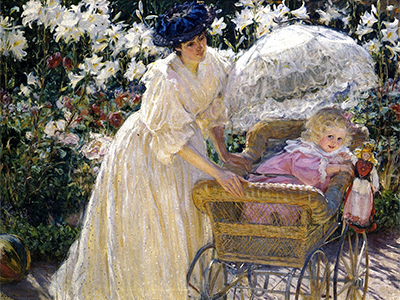
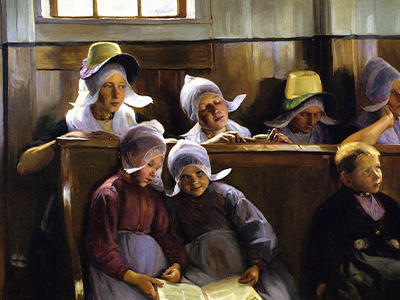
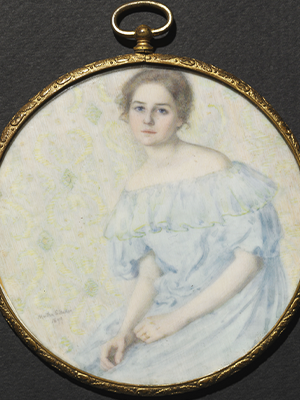
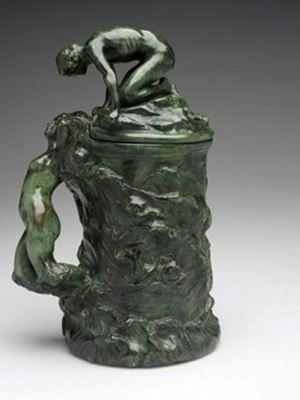
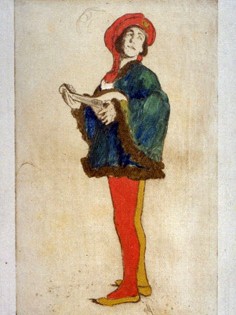
![Della Garretson, “Miss G” [her twin sister, Lillie Garretson], ca. 1902, oil on canvas. Detroit Institute of Arts. Della Garretson, “Miss G” [her twin sister, Lillie Garretson], ca. 1902, oil on canvas. Detroit Institute of Arts](/sites/default/files/styles/cu_crop/public/content/Garretson%20Della.png?itok=caikubMg)
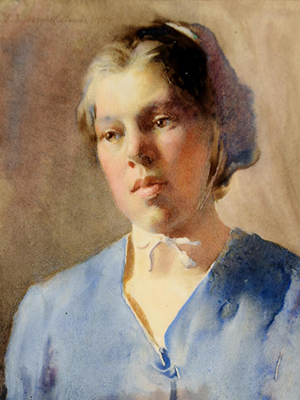
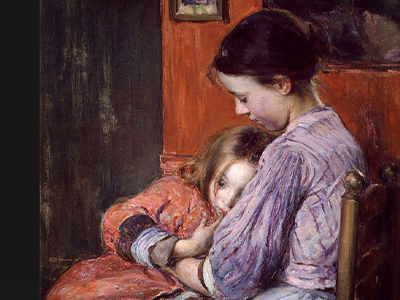
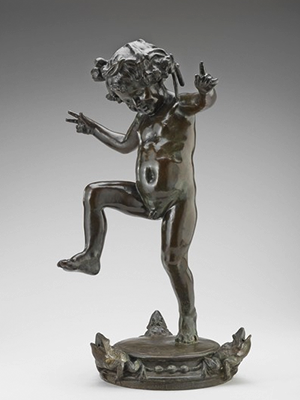
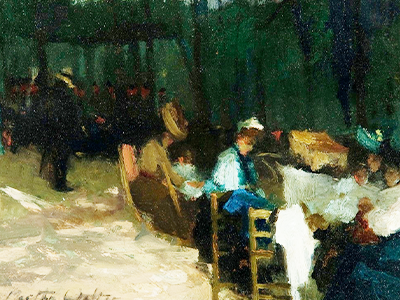
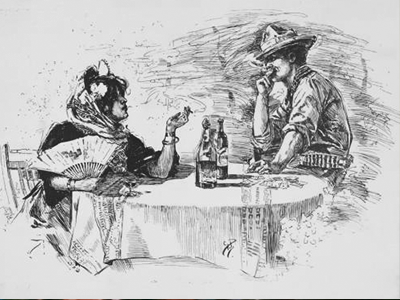
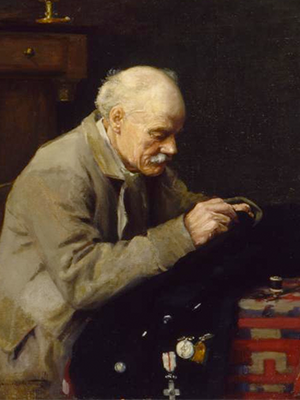
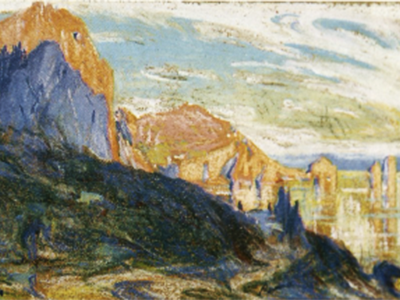
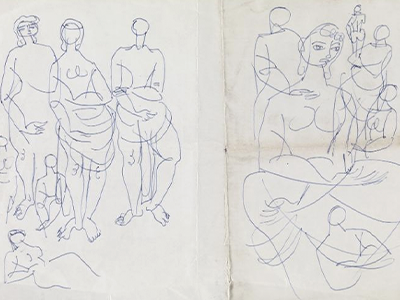
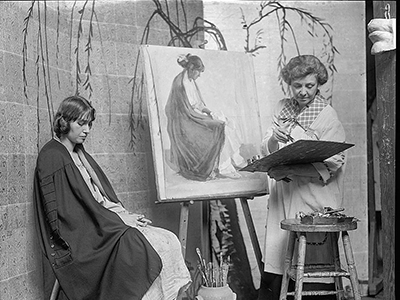
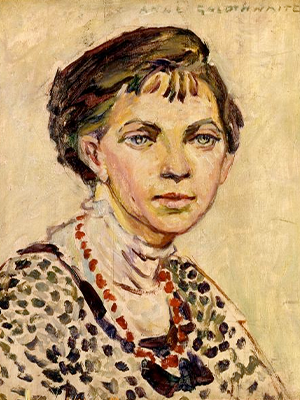
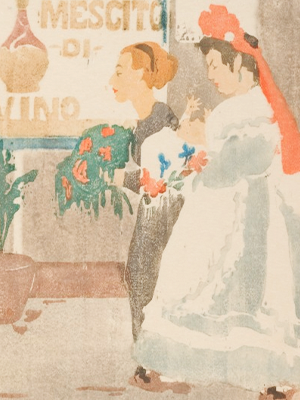
![Ethel Mars, “Woman with a Monkey” [possible self-portrait], 1909, oil on canvas, Springfield Art Association. Ethel Mars, “Woman with a Monkey” [possible self-portrait], 1909, oil on canvas, Springfield Art Association](/sites/default/files/styles/cu_crop/public/content/Mars_0.png?itok=FUwRNnQN)
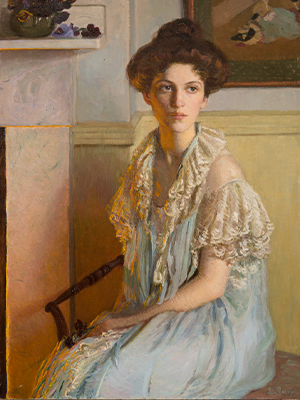
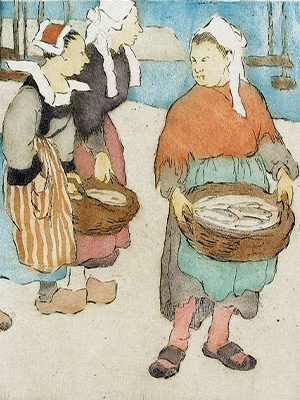
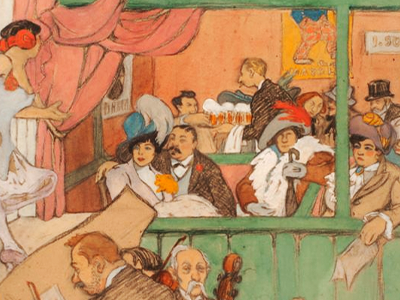
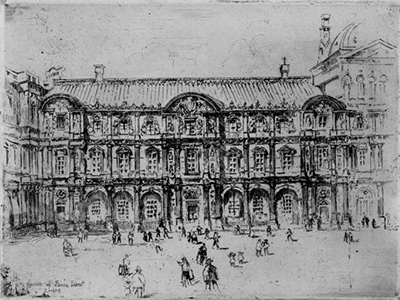
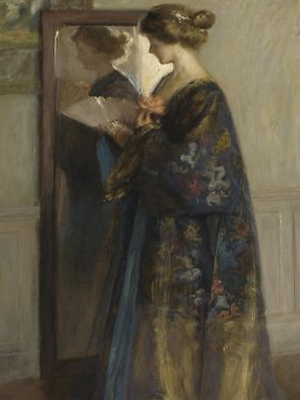
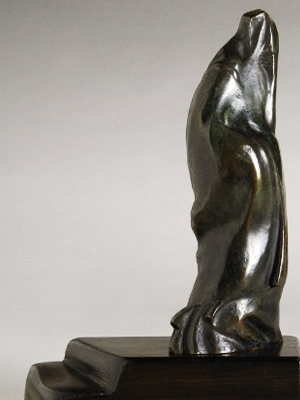
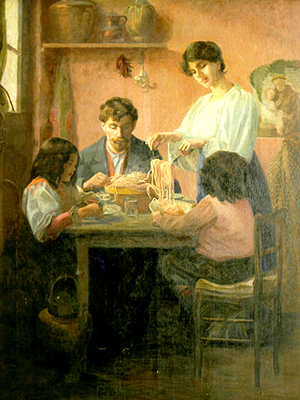
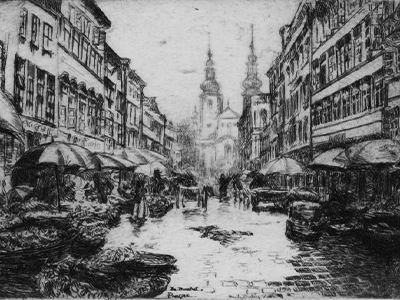
![John Singer Sargent, “Mrs. Edward Darley Boit [Mary Louisa Cushing],” 1887, oil on canvas, The Metropolitan Museum of Art. John Singer Sargent, “Mrs. Edward Darley Boit [Mary Louisa Cushing],” 1887, oil on canvas, The Metropolitan Museum of Art](/sites/default/files/styles/cu_crop/public/content/Boit.png?itok=OY1_7g7N)
